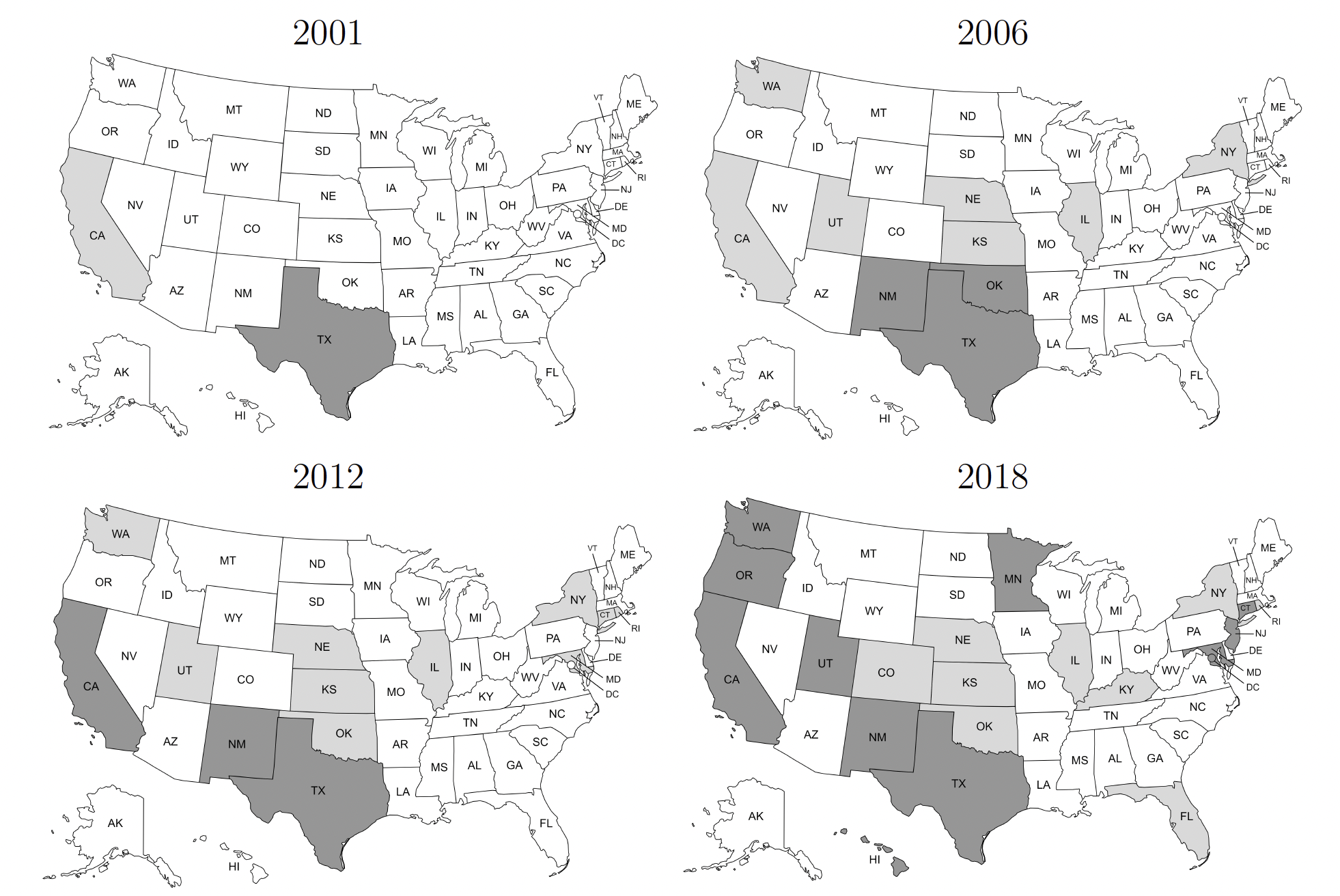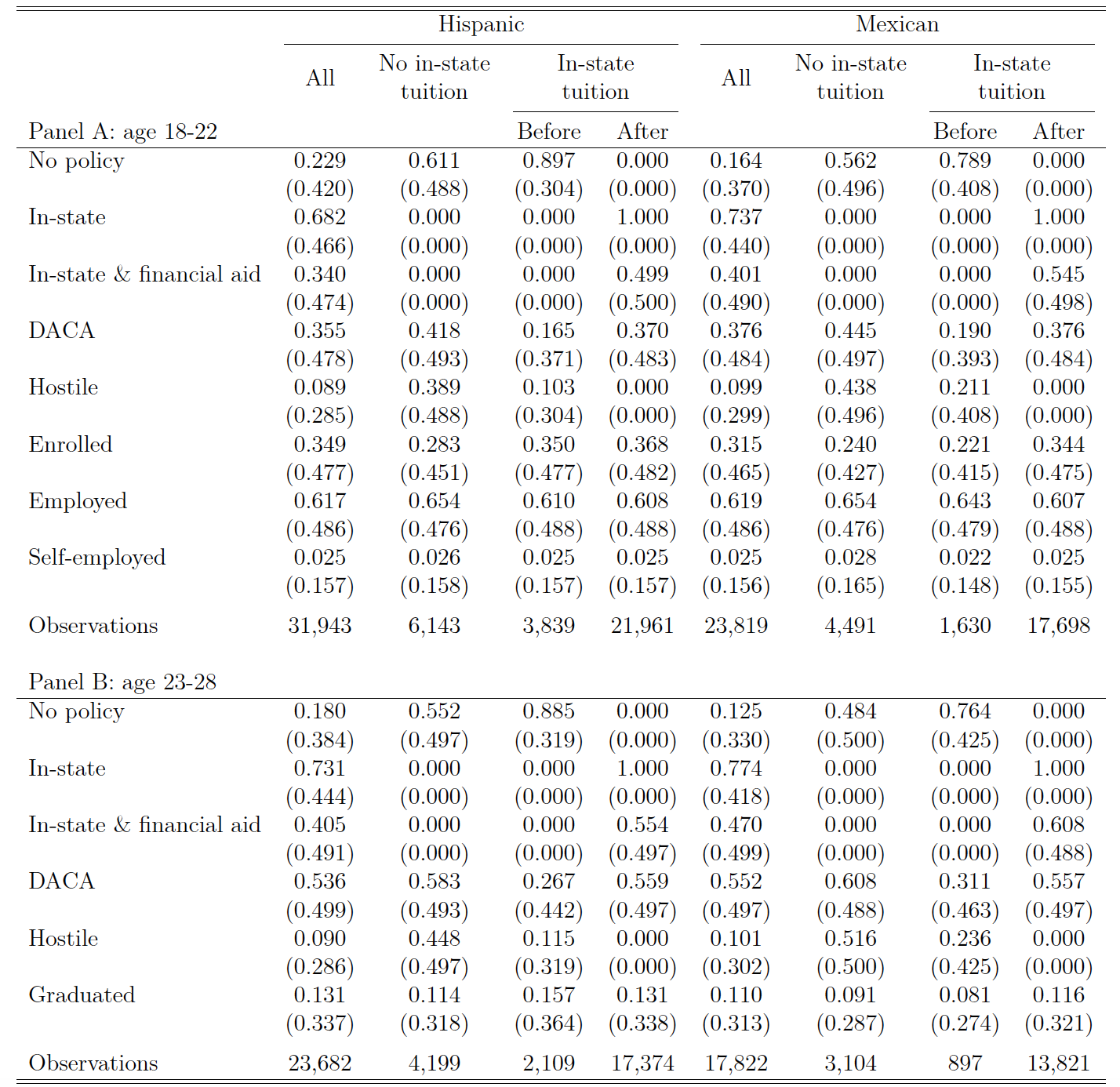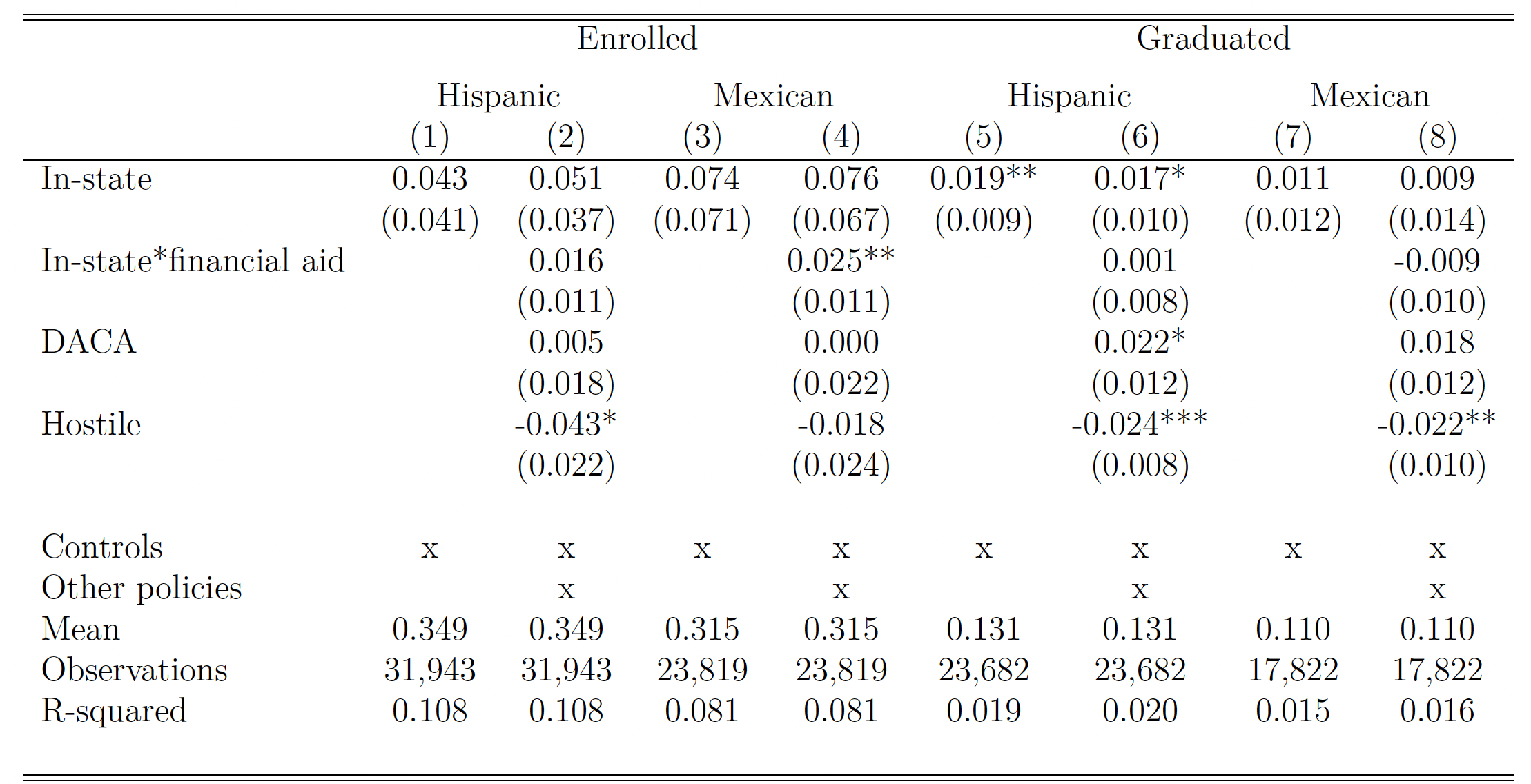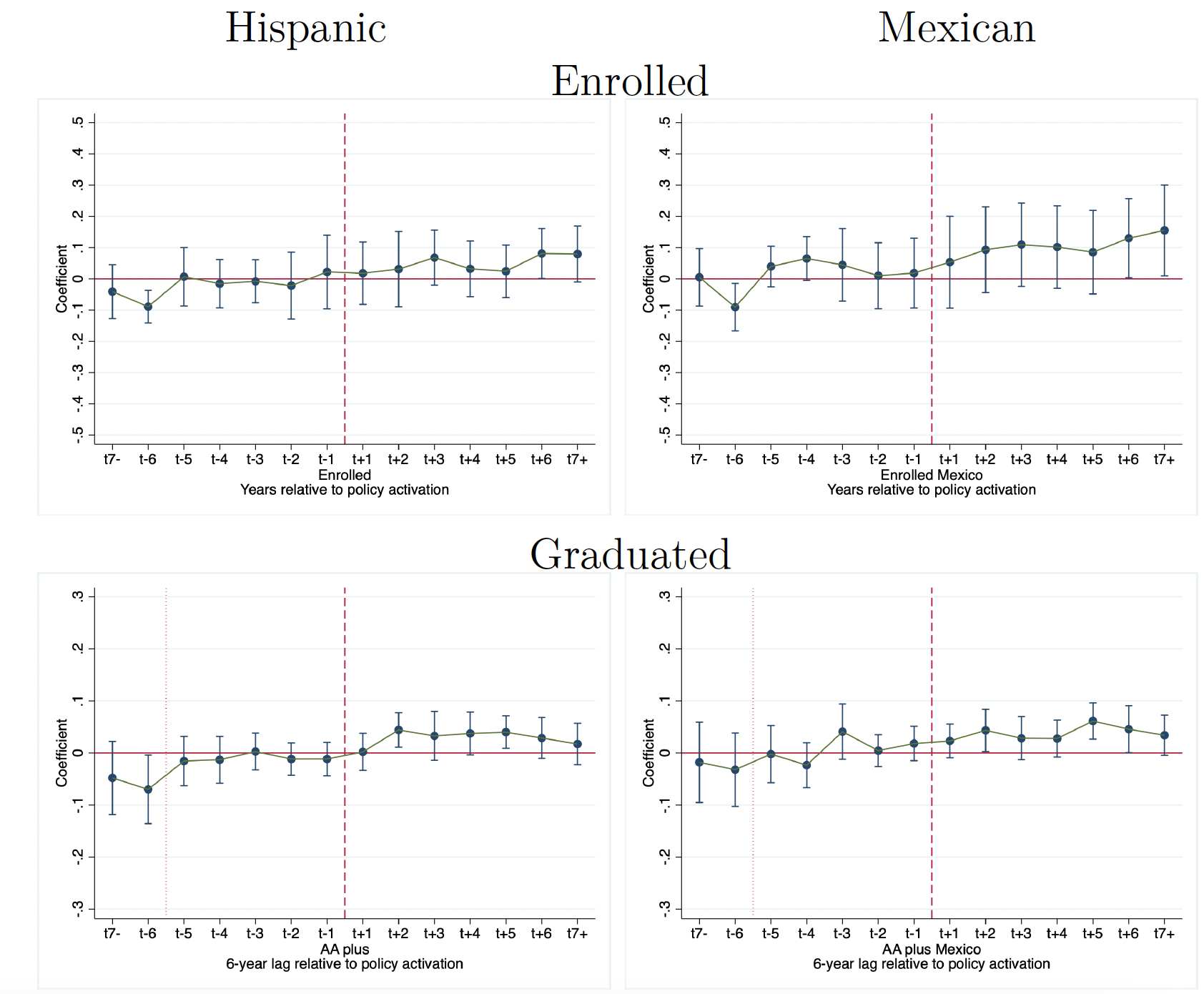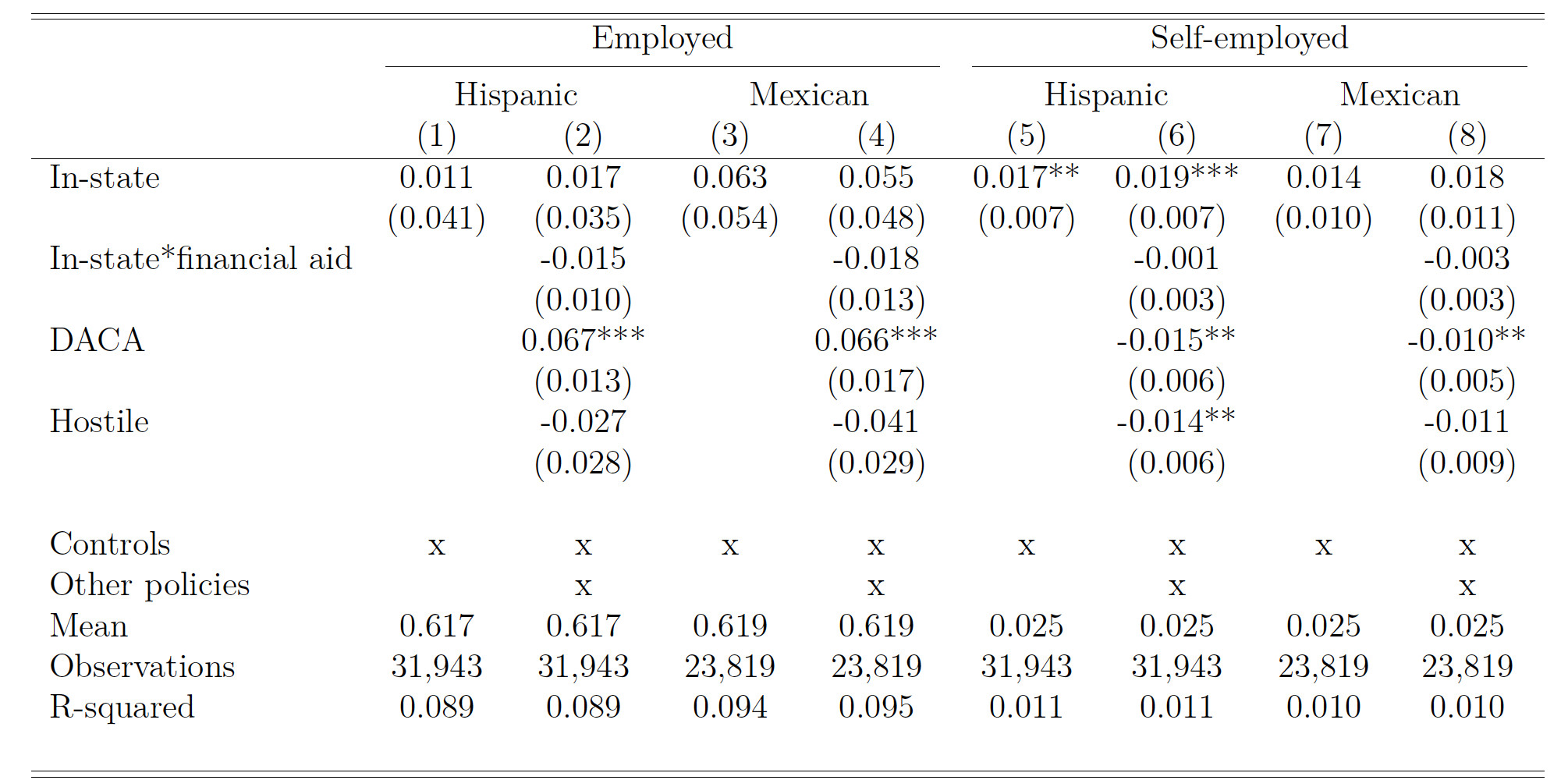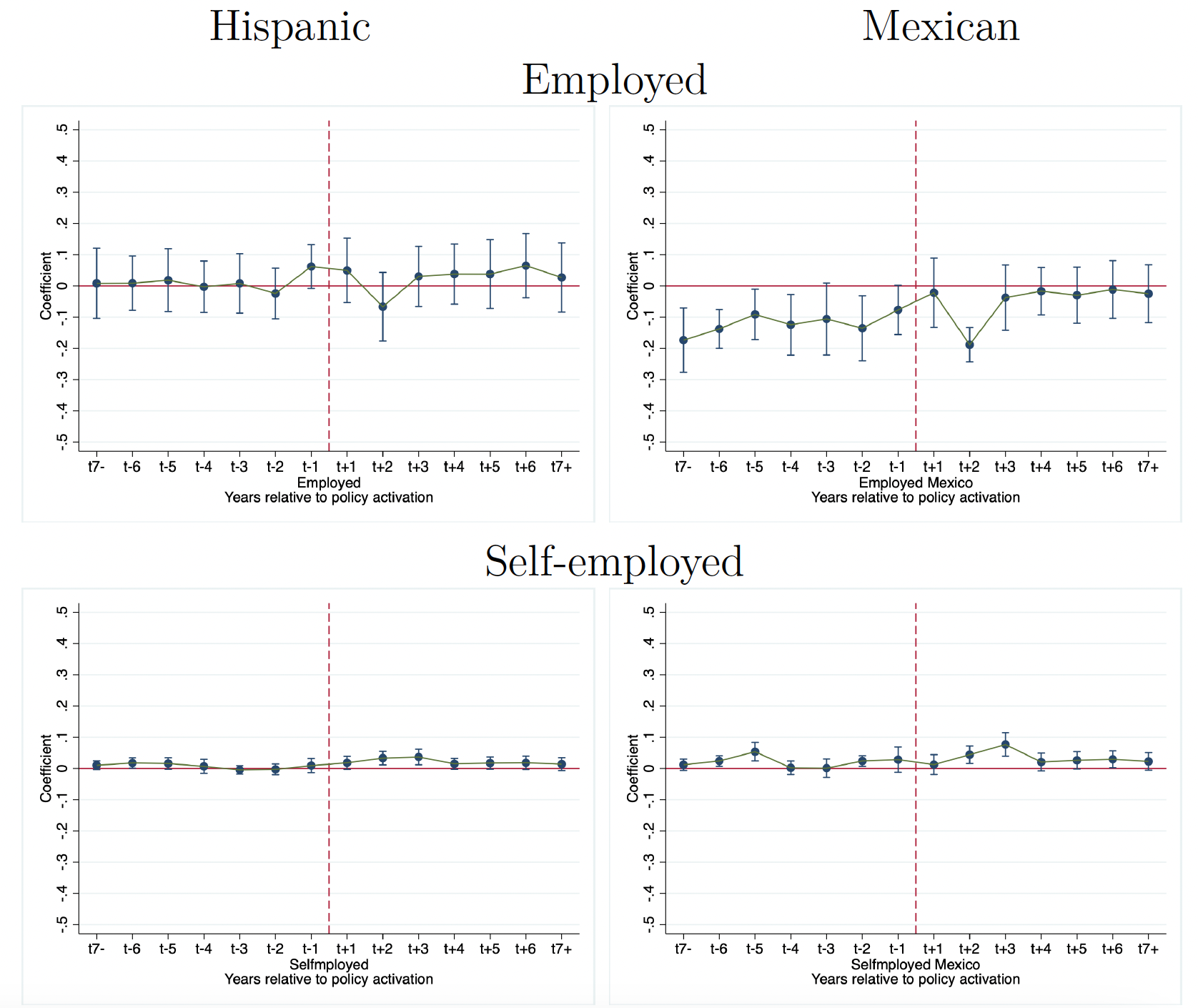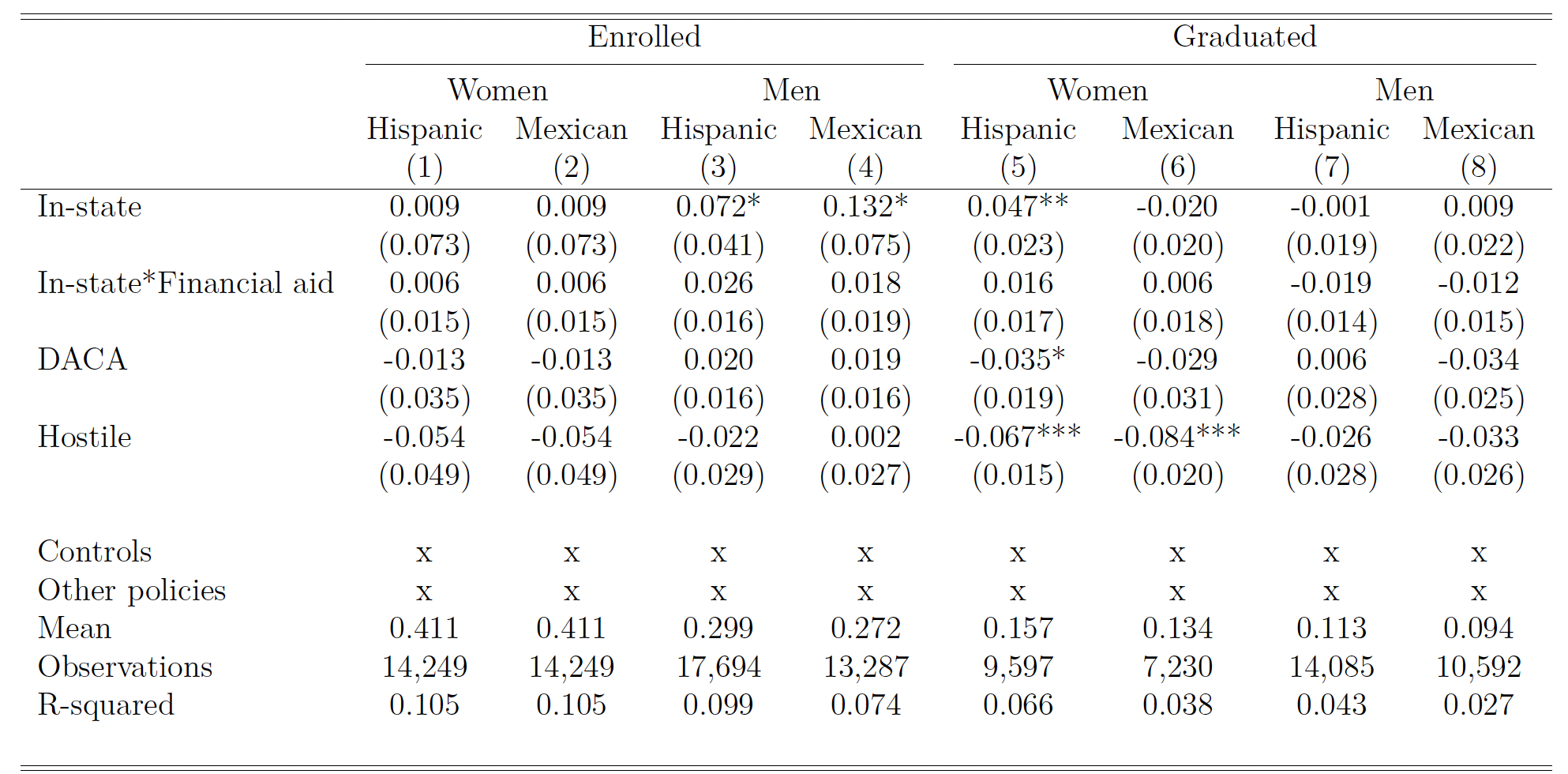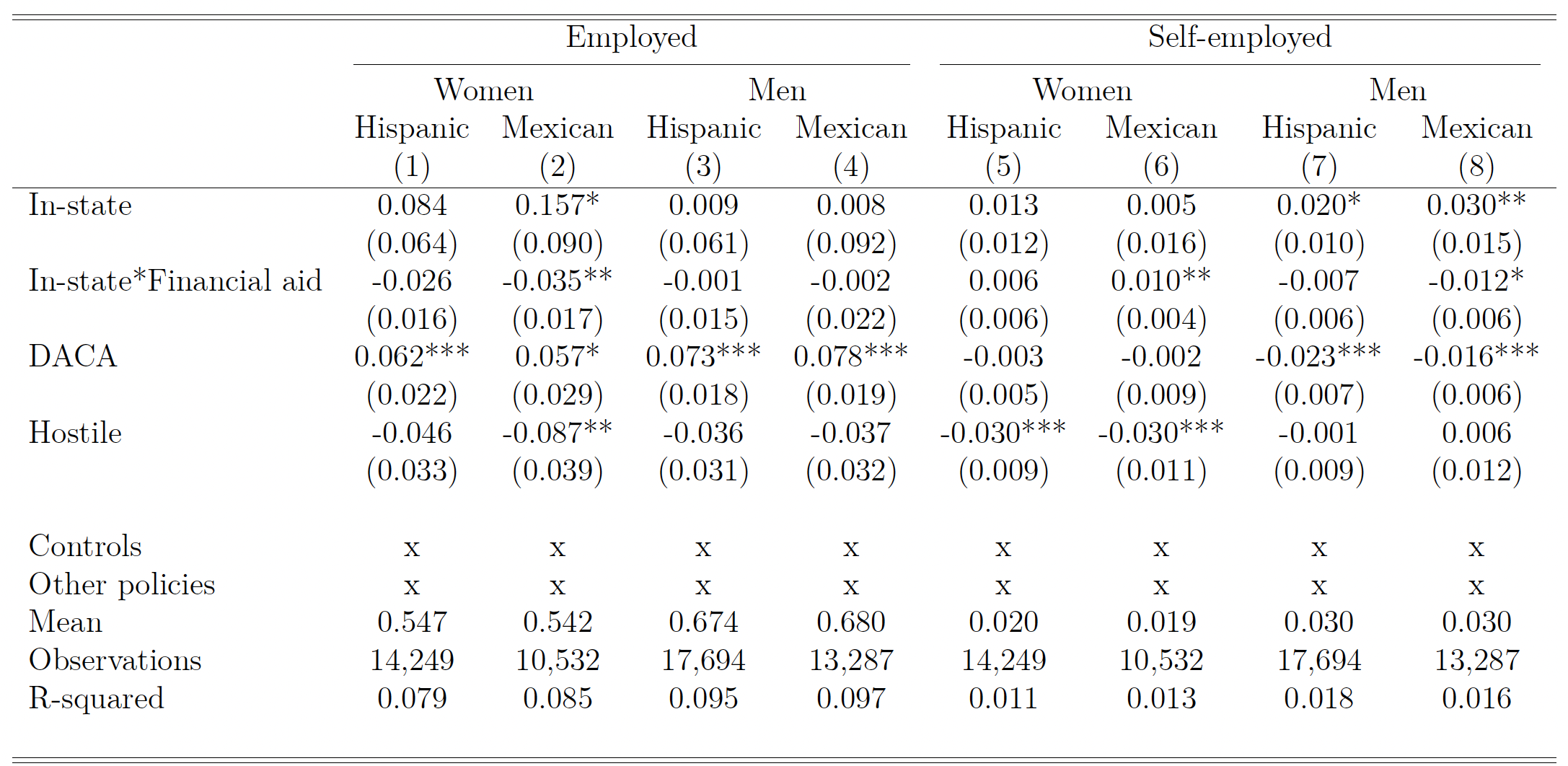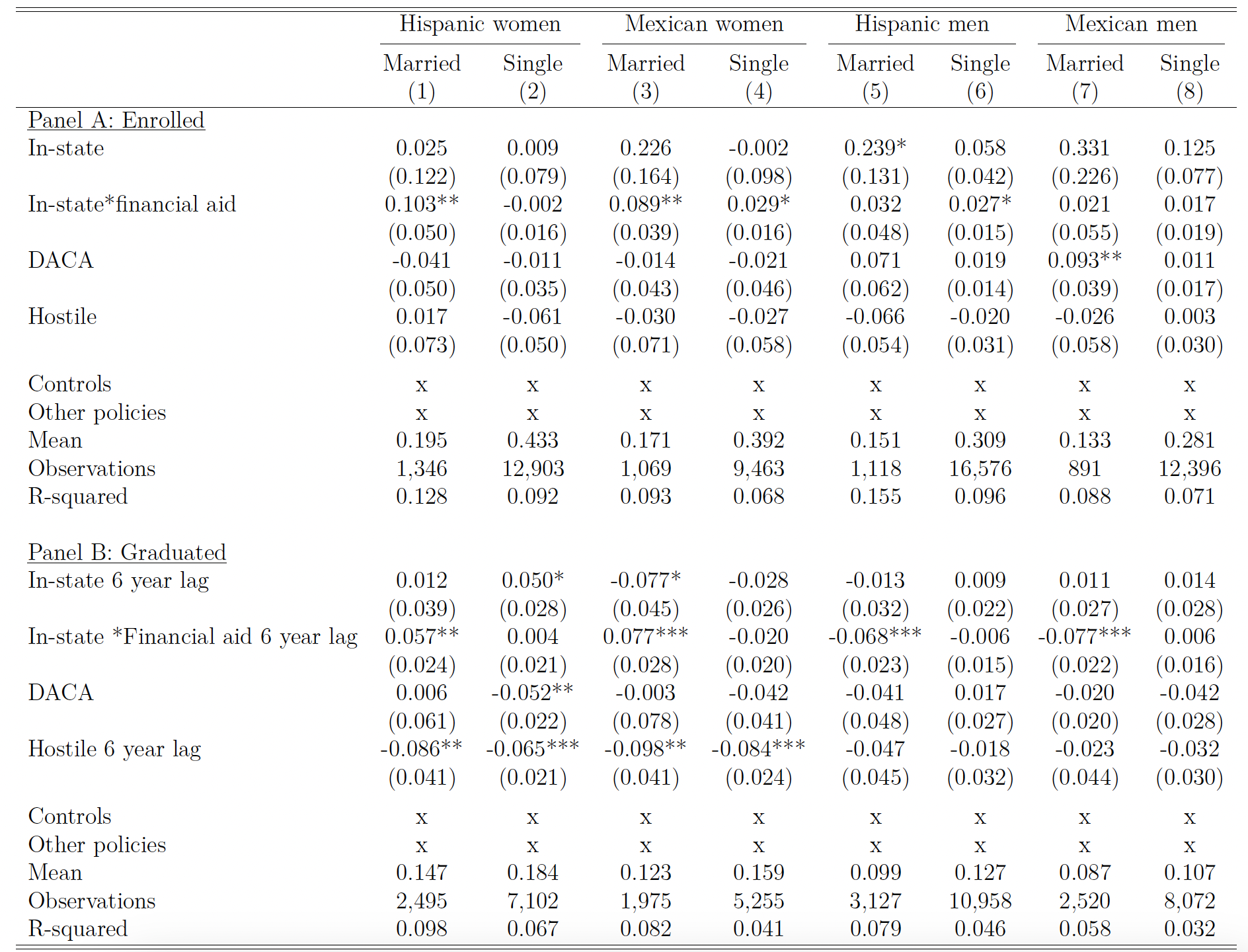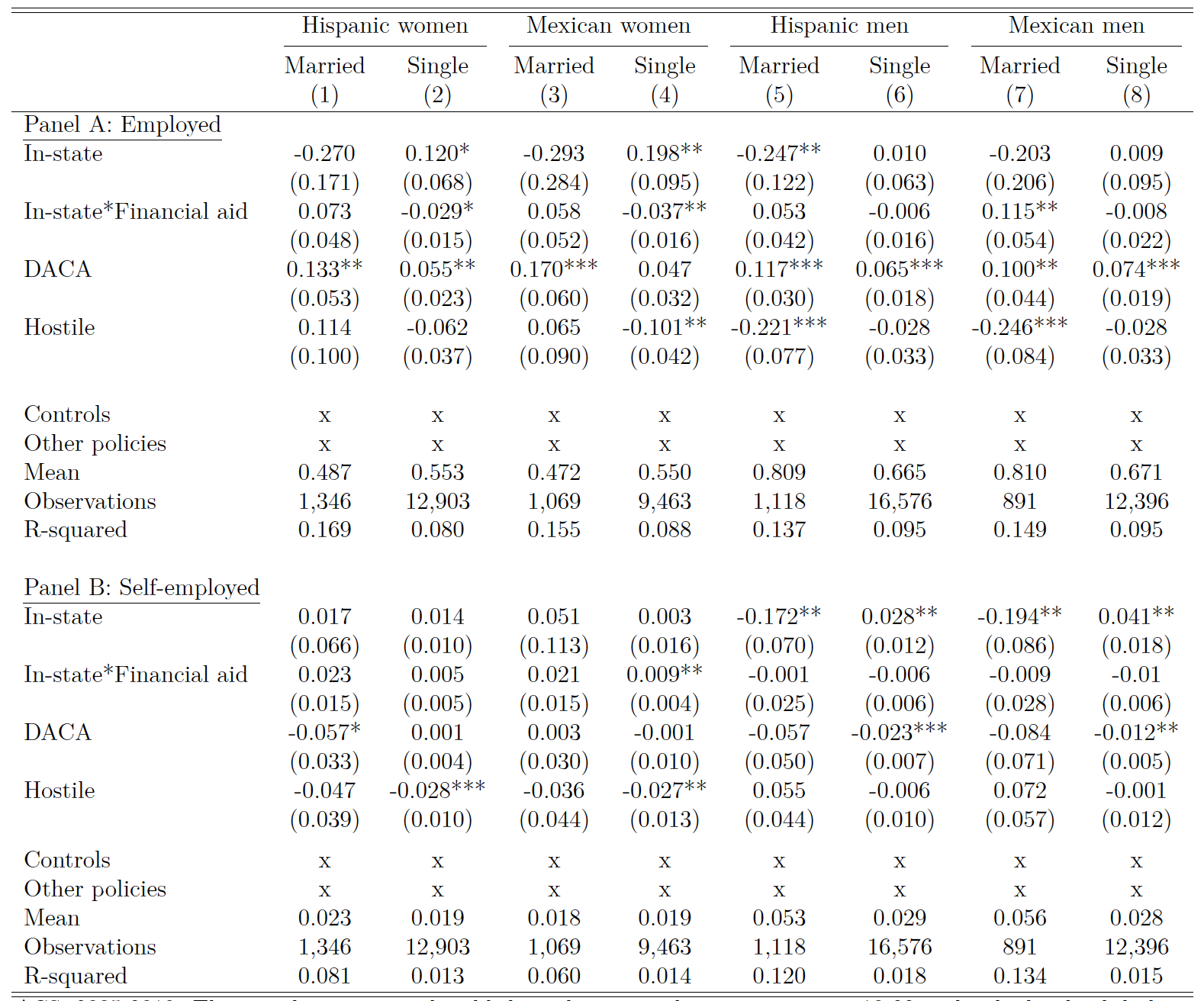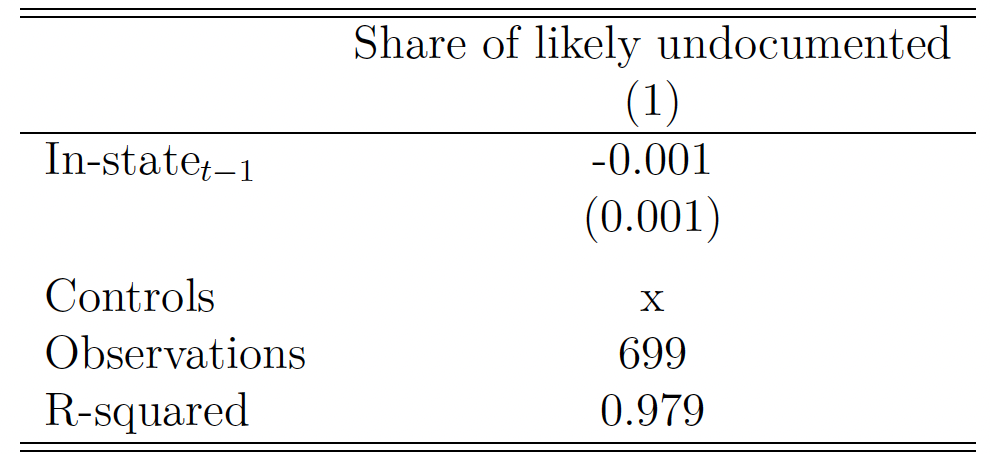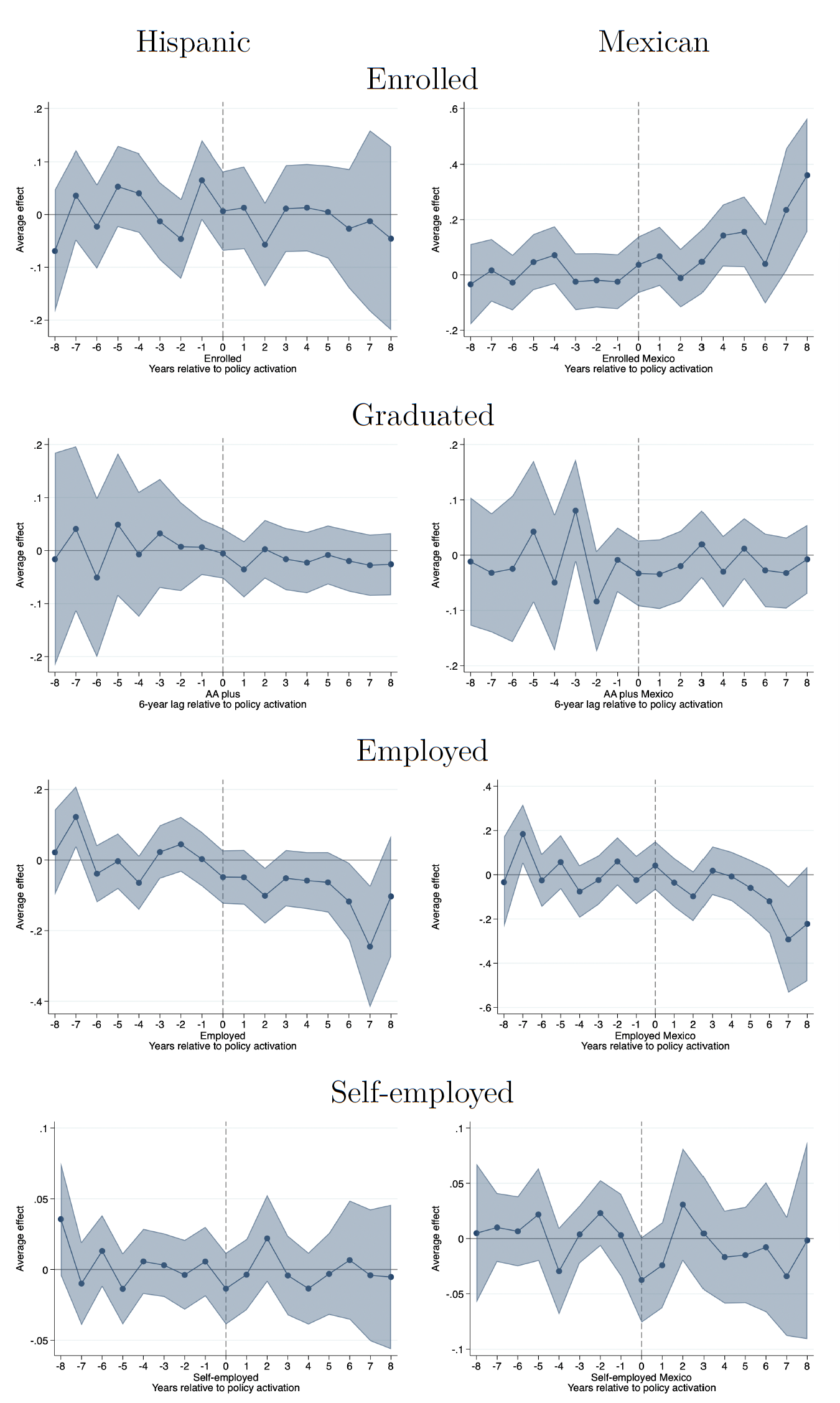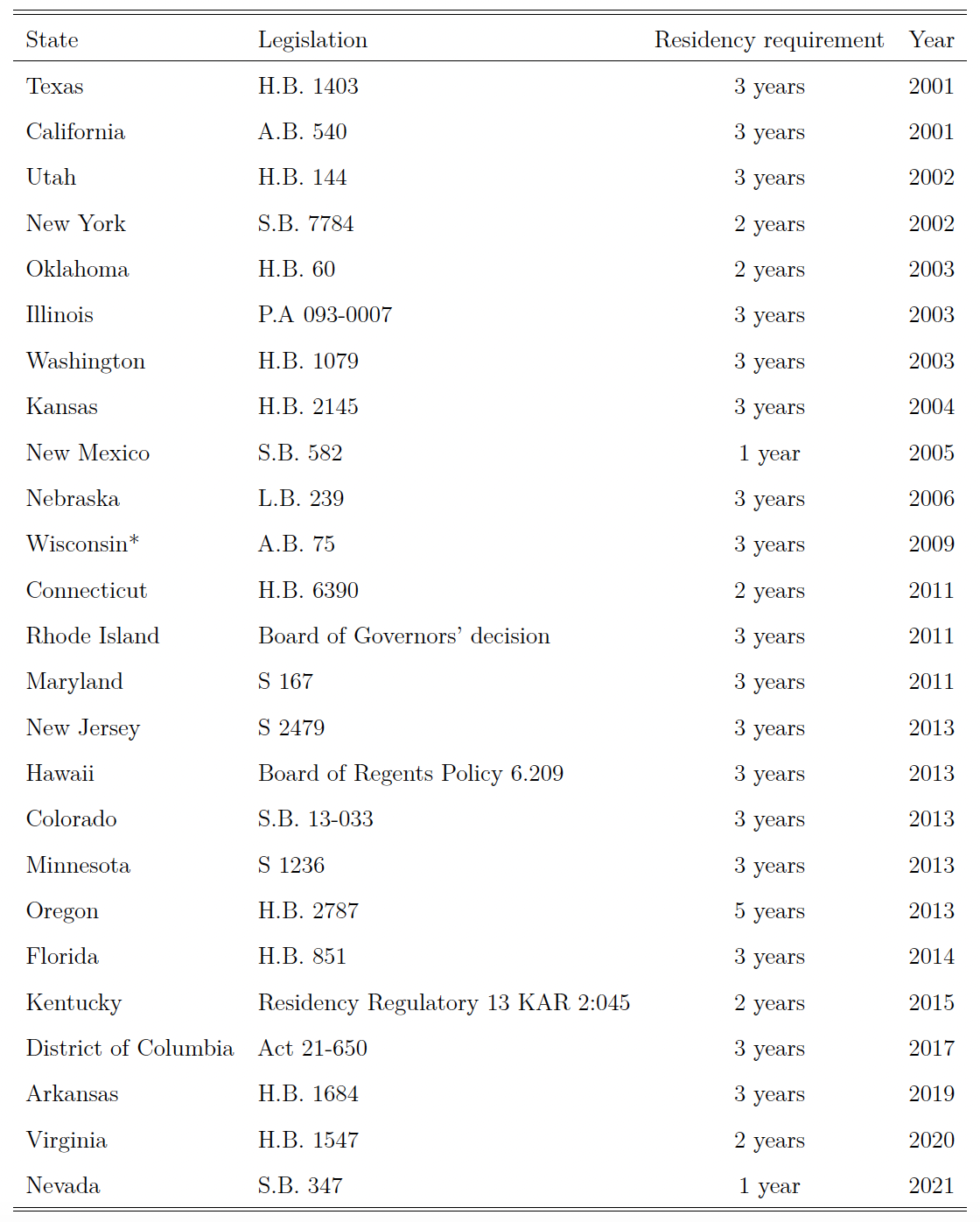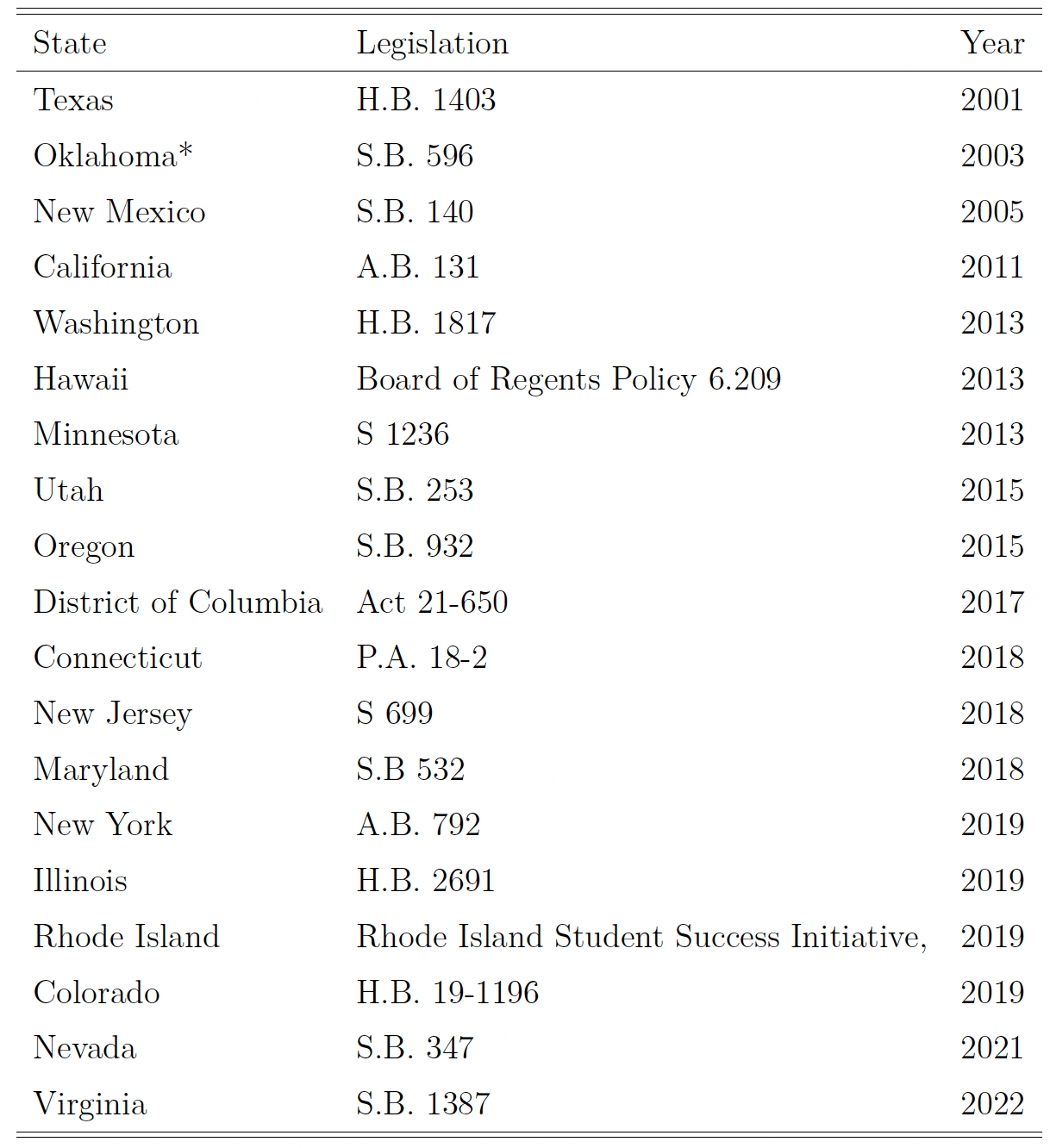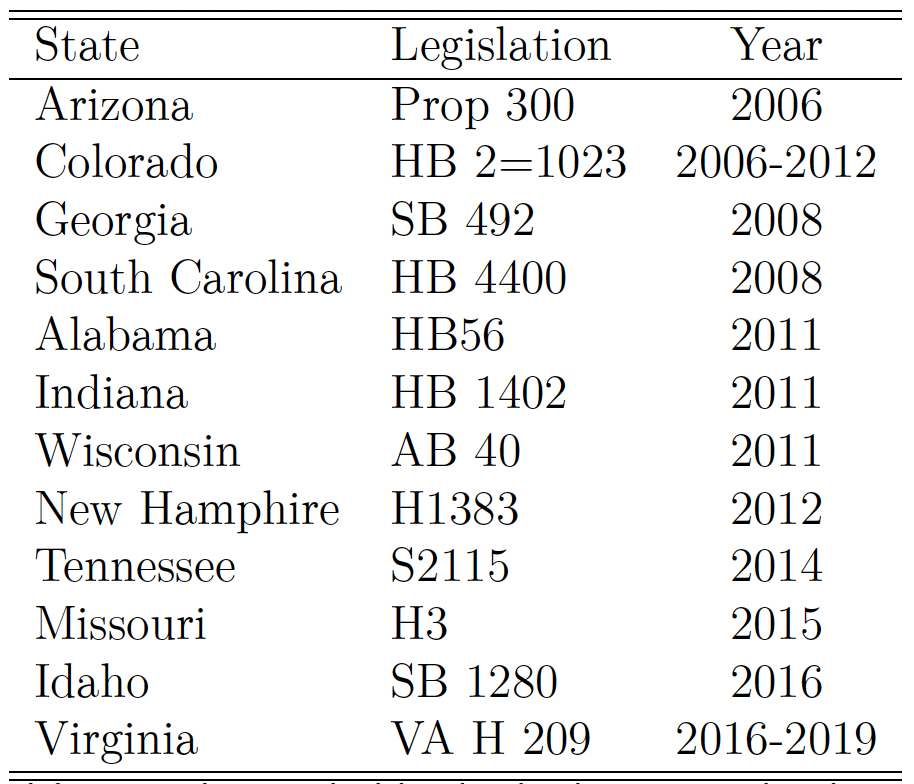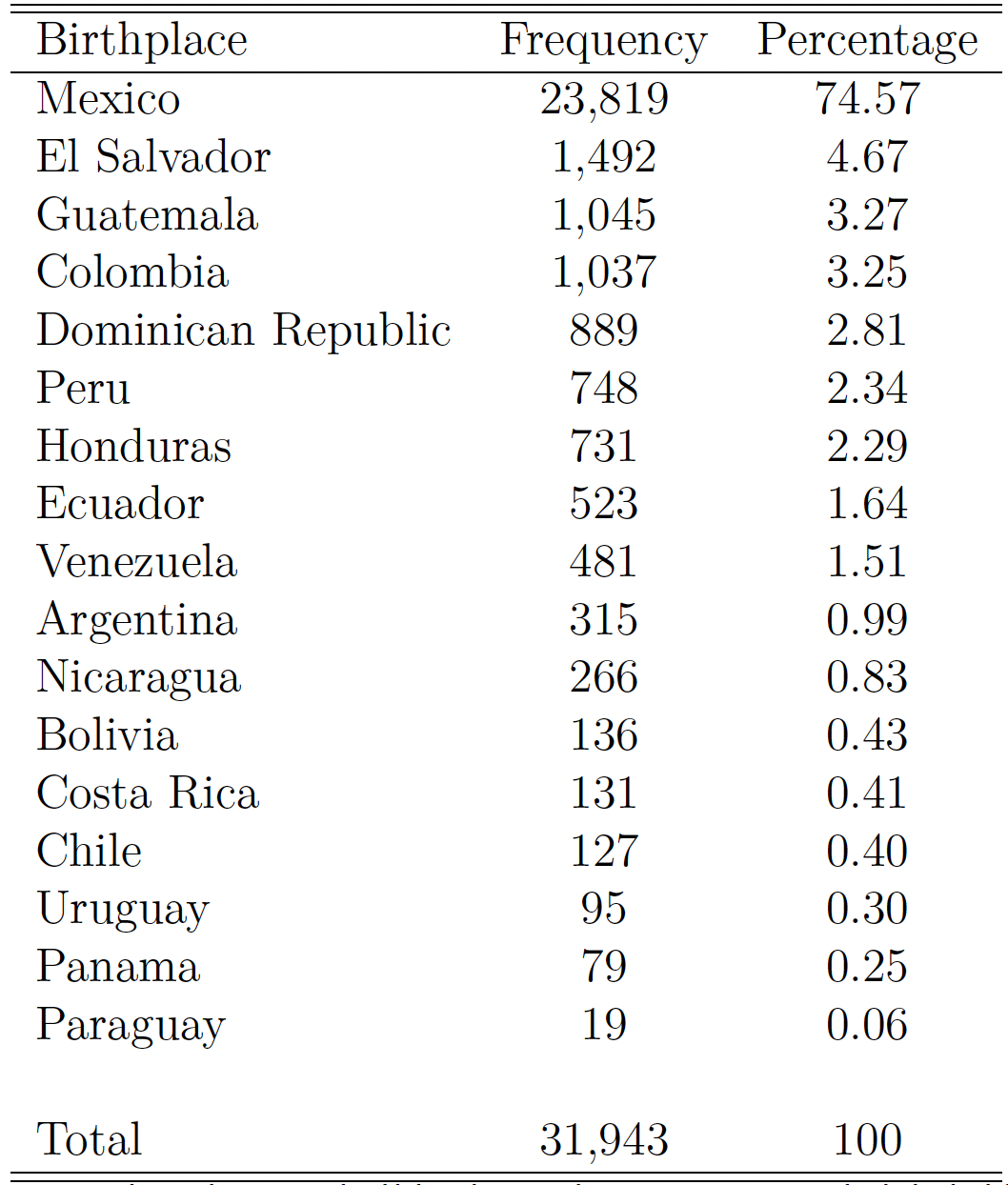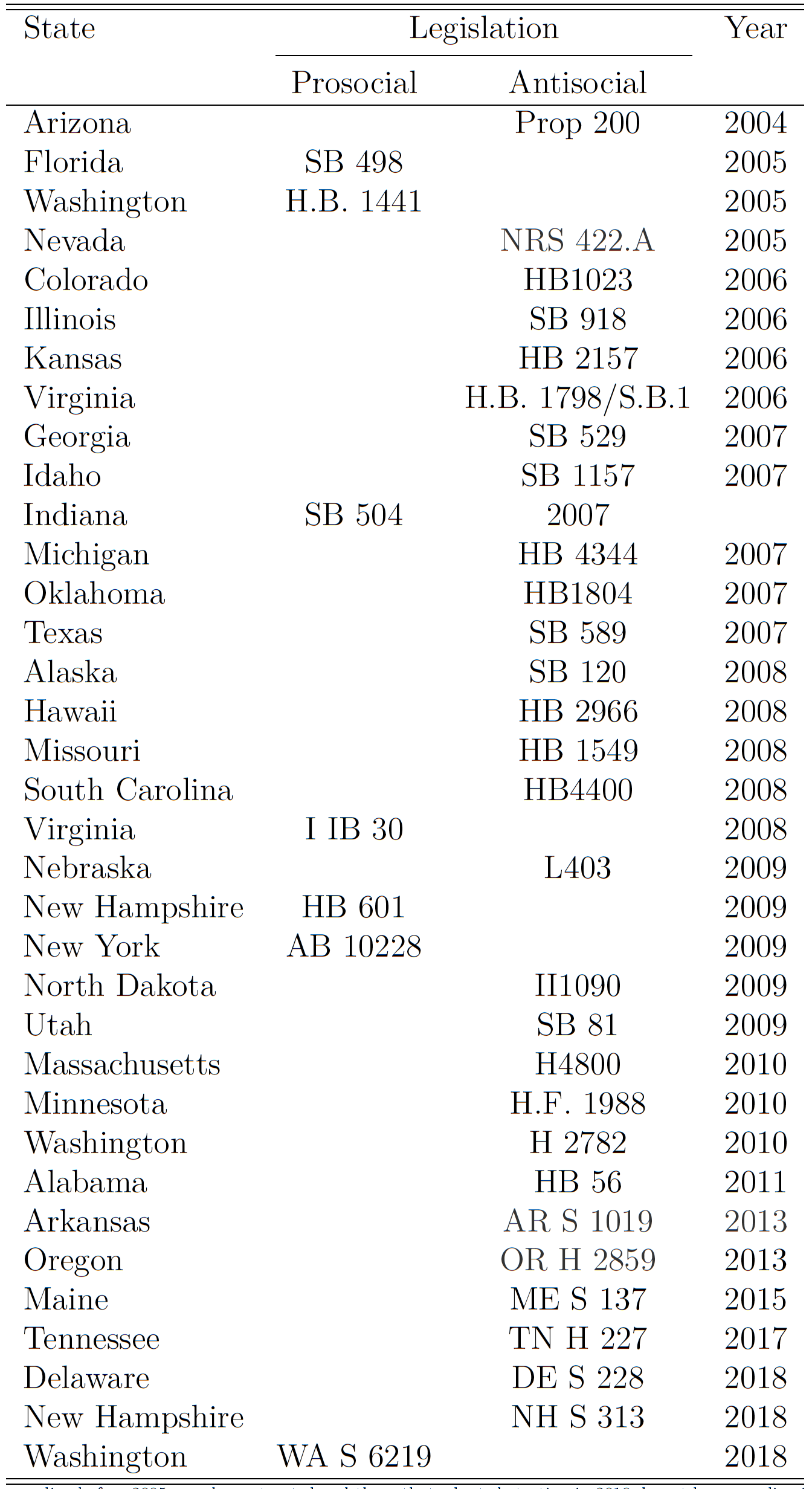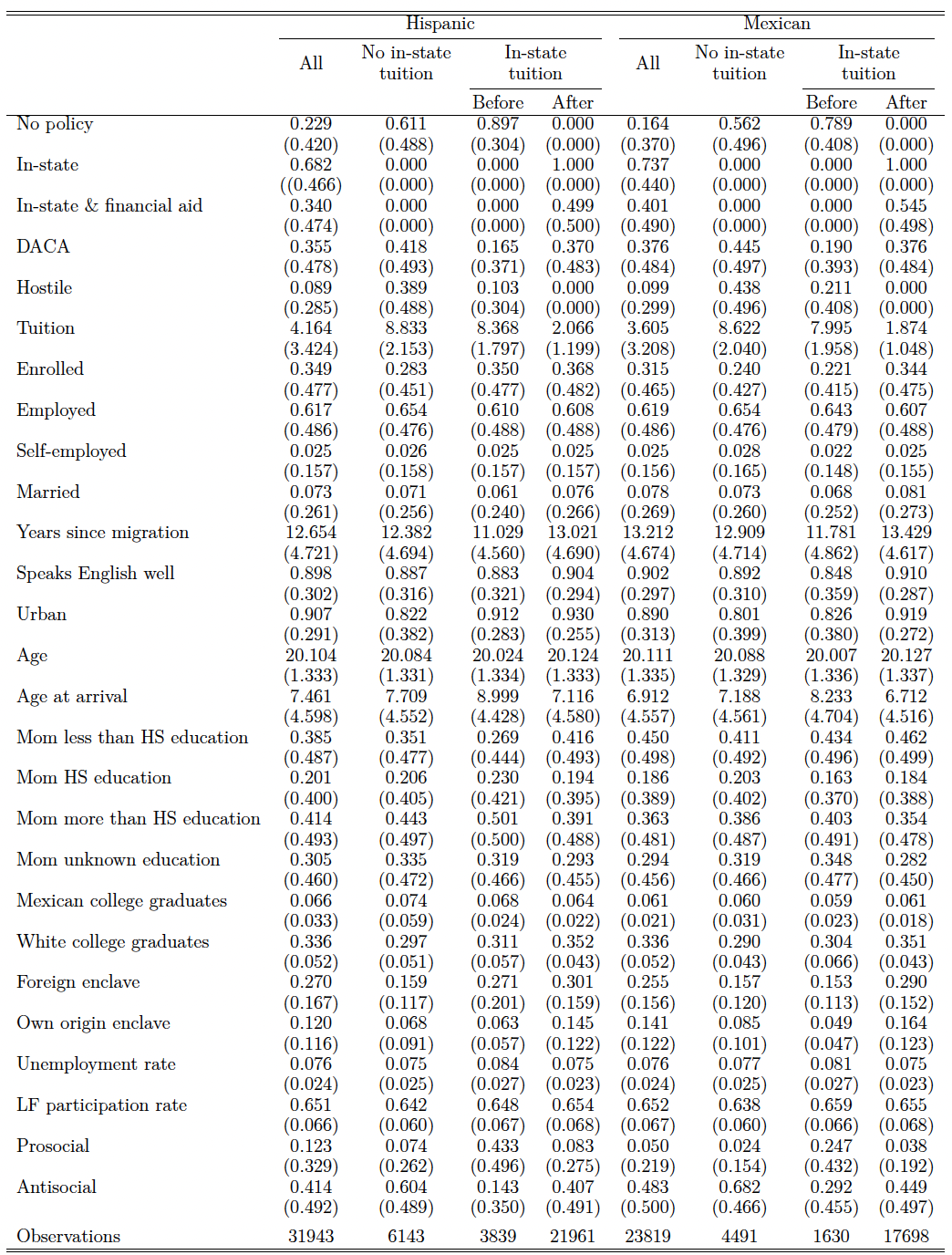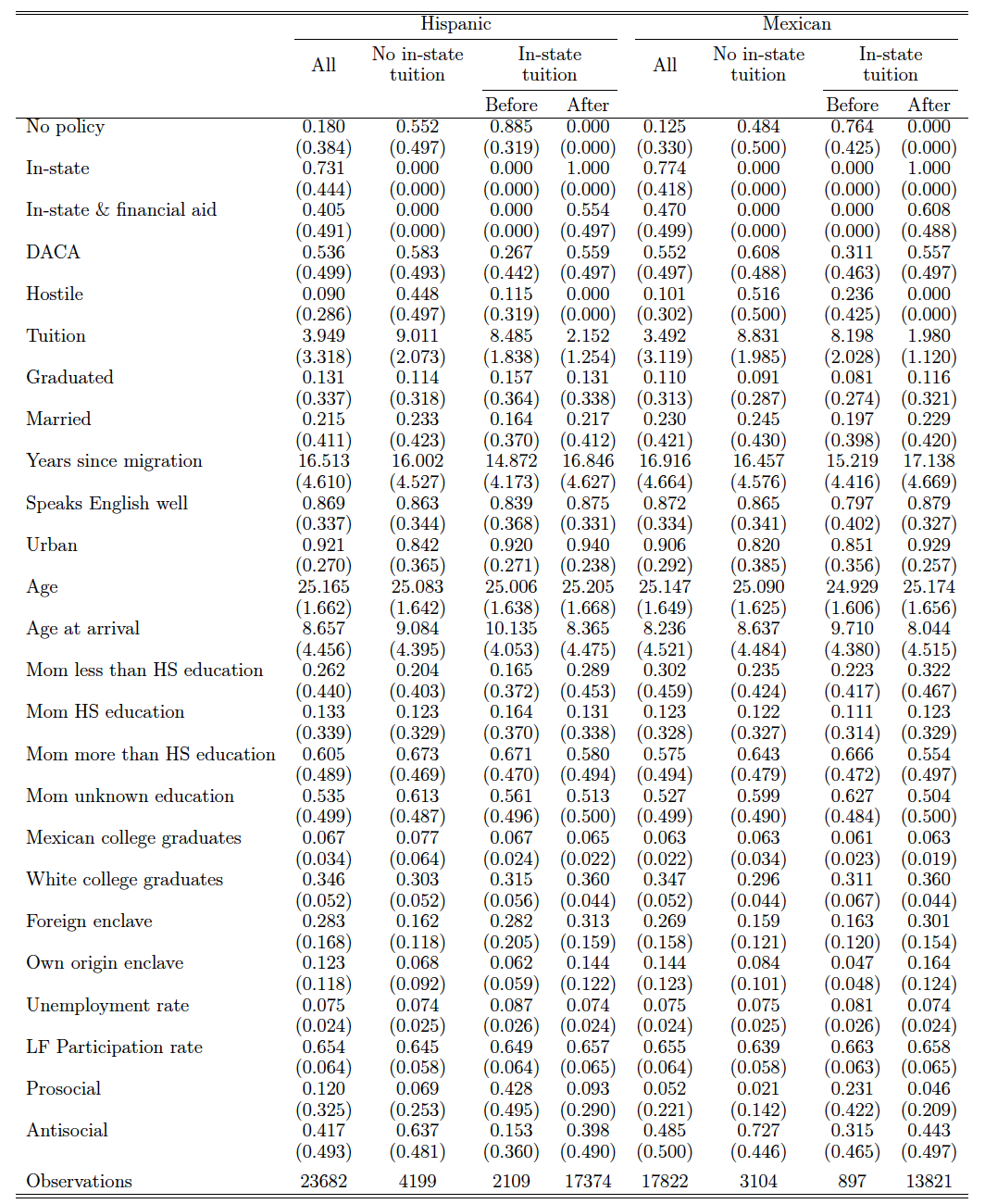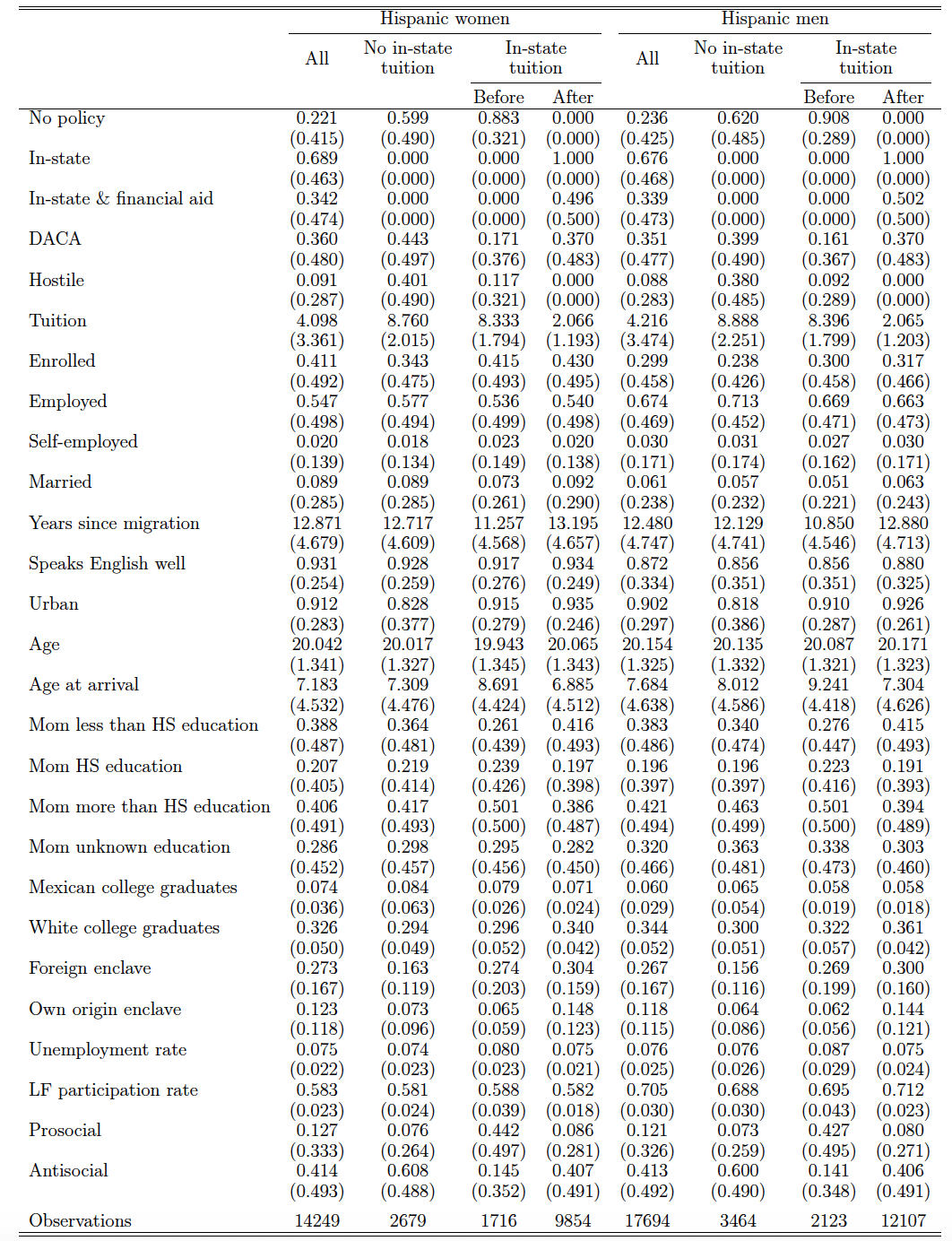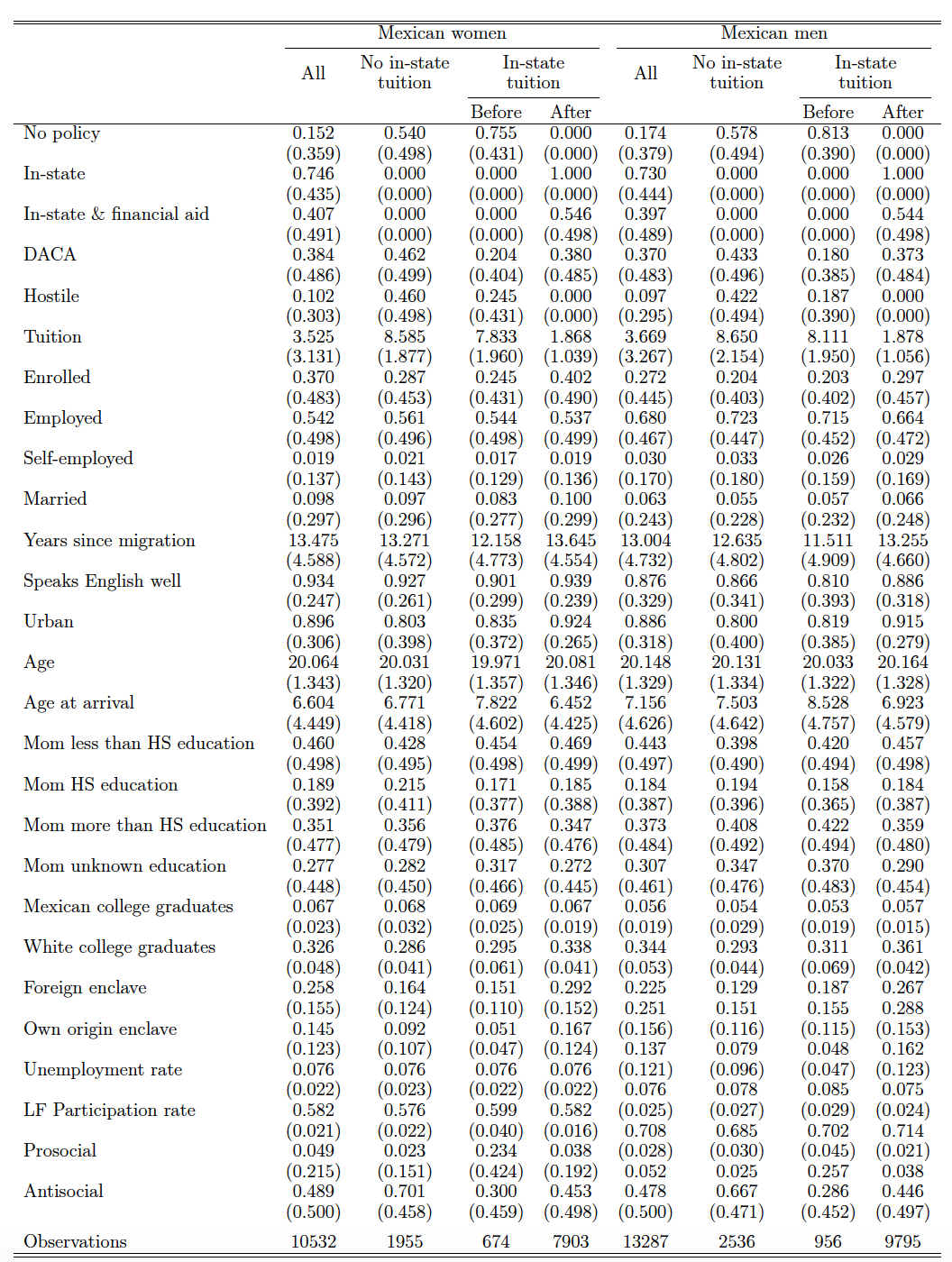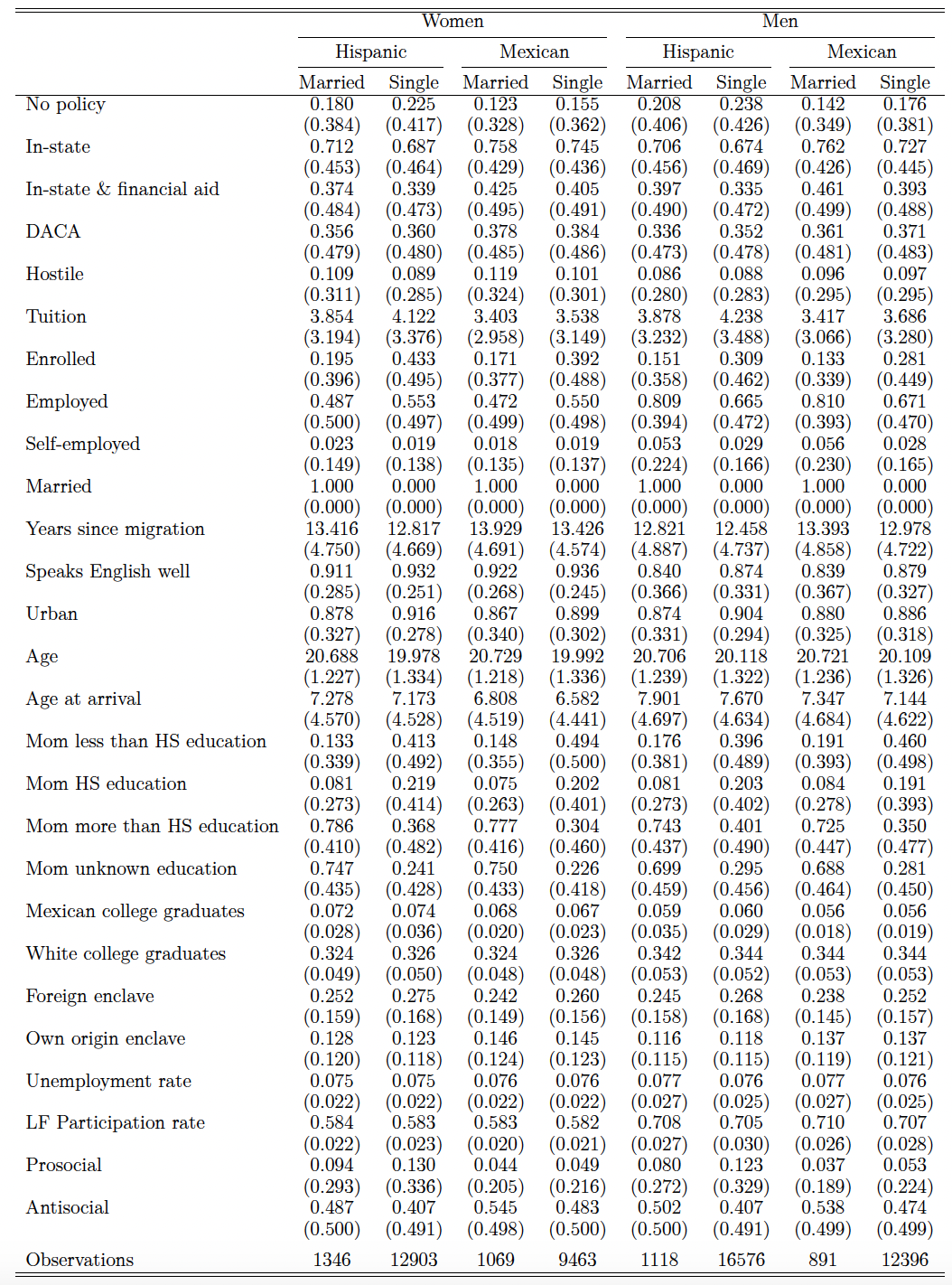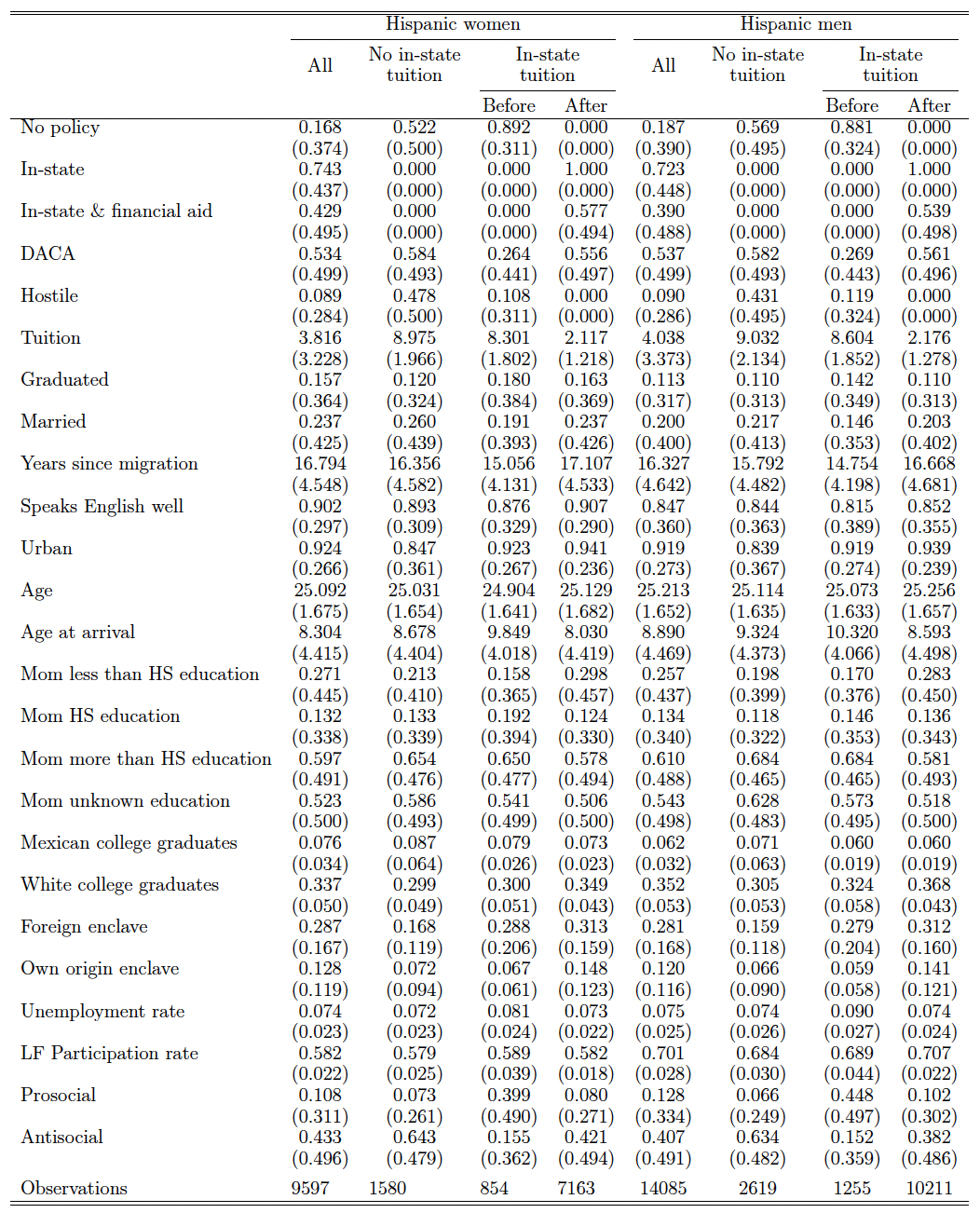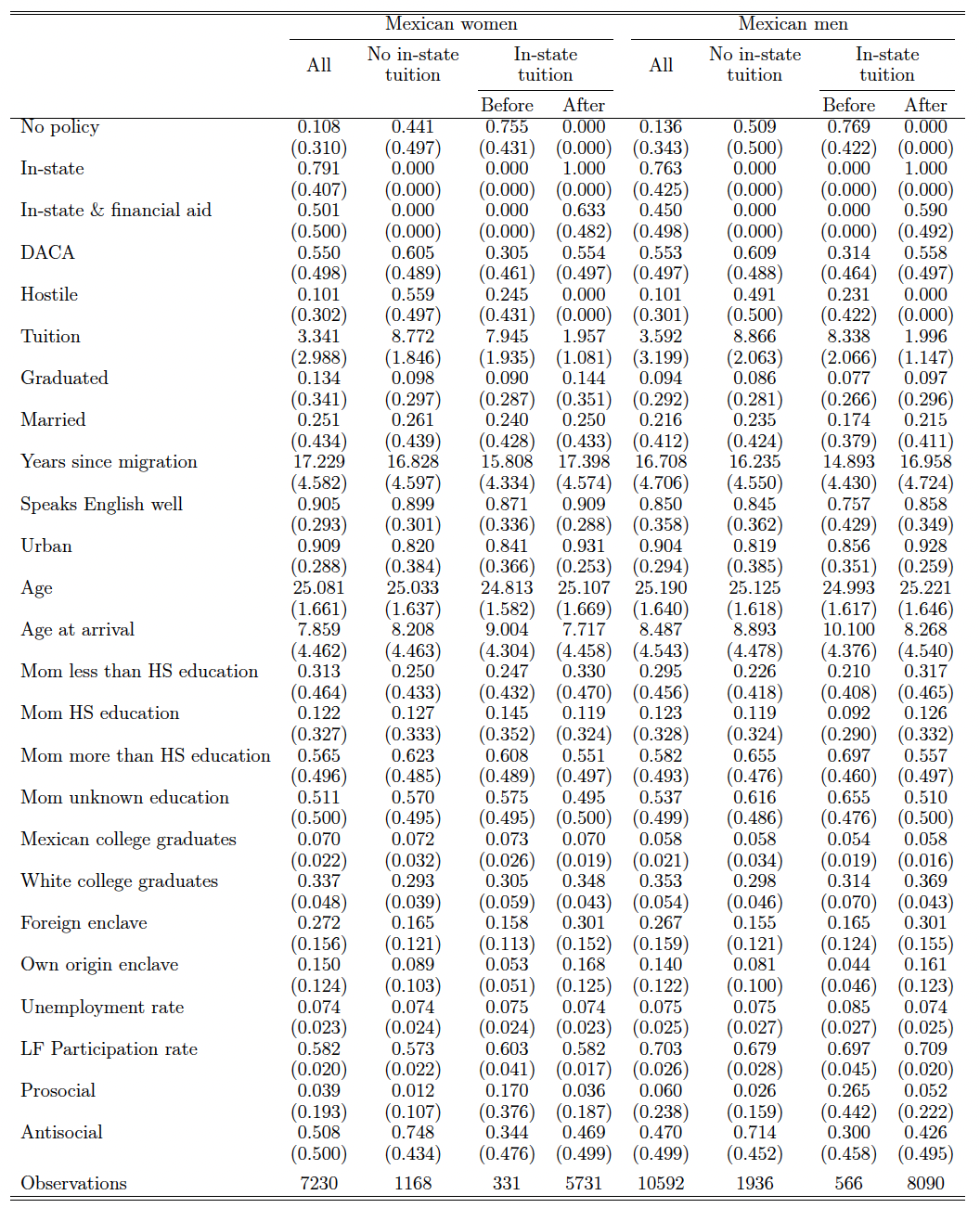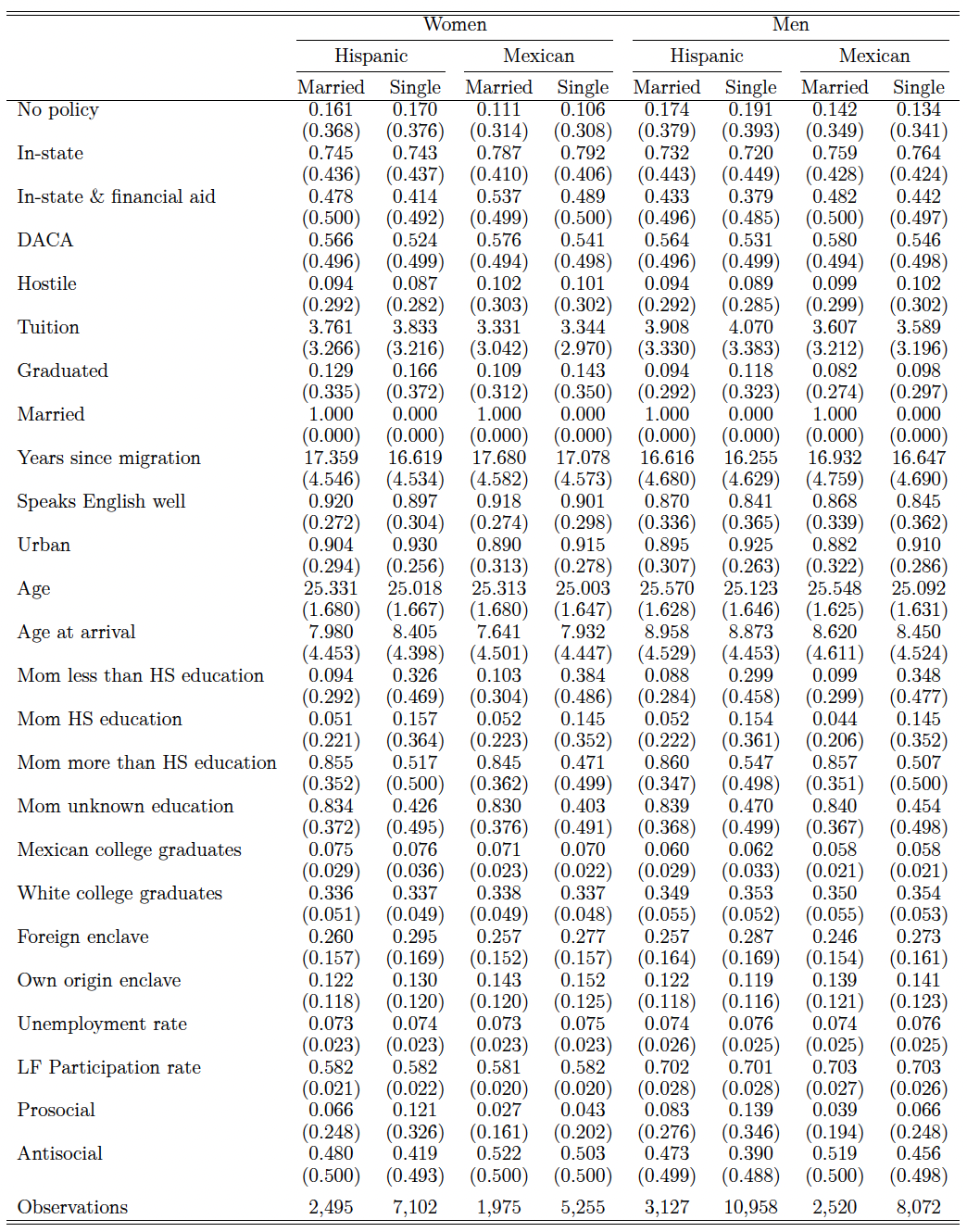1 Introduction
Undocumented immigrant children in the U.S. often face different educational opportunities compared to their native-born counterparts. These differences vary across states, by time, and by the age of the child. While at the federal level, Plyler v. Doe (1982) guarantees undocumented students a right to free public K-12 education, this equal access does not apply to higher education. In particular, Section 505 of the Illegal Immigration Reform and Immigrant Responsibility Act (IIRIRA) of 1996 bars states from providing undocumented students post-secondary education benefits that they do not offer to all U.S. citizens (National Conference of State Legislatures, 2021). This legislation restricts these students from accessing in-state college tuition rates as these subsidies are not offered universally to U.S. citizens. While approximately 65,000 undocumented students graduate from U.S. high schools every year, only 5 to 10 percent pursue higher education compared to the national average of 62.5 percent, and even fewer graduate (US Department of Education, 2015).
Although the IIRIRA still stands, since 2001 over 20 states have passed work-around legislation providing access to in-state benefits for undocumented immigrants, and a subset of these states have also extended access to financial aid for this population. However, these immigrant-friendly policies continue to be actively challenged in court.11For example, California’s policy was upheld by the state supreme court in 2010 (Feldblum et al., 2020). On the other hand, some states have enacted hostile policies to limit higher education access for the undocumented and have passed legislation explicitly banning these individuals from paying in-state tuition.
Studies show that a large proportion of undocumented youth are likely to remain in the U.S. regardless of whether or not they have access to college education (National Conference of State Legislatures, 2021). Yet, without a college degree, participation and opportunities in the U.S. economy are more limited, reducing social mobility. Research finds that if undocumented students pursued higher education and gained access to better-paying jobs, they would pay considerably more in taxes (Gee et al., 2016). Moreover, existing research highlights the relatively large societal gains from degree completion in community colleges for low-income populations (Evans et al., 2020). Therefore, some states have recognized the benefits of granting undocumented youth opportunities to improve their educational outcomes and to pursue higher education by reducing the financial barriers to attending college.
While the majority of research to date shows an increase in enrollment following the expansion of access to in-state college tuition, we corroborate the more recent research that finds no impact on the aggregate enrollment rates when properly controlling for additional policies (Bozick et al., 2016). This research identifies the critical importance of financial aid availability, hostile educational policies, and other social policies targeted at undocumented immigrants in measuring the impact of in-state tuition access. Newly available data, which doubles the number of new states implementing additional policies, allow us to assess the impact on graduation—the completion of at least an Associate’s (AA) degree. These two-year degrees, offered at community colleges, allow for more flexible attendance and are geographically accessible to low-income populations. When examining this outcome that is not assessed by the majority of previous research studies, we find an increase in graduation rates in response to in-state tuition accessibility. We also analyze the labor market attachment of eligible youth by examining the probability of employment and self-employment for undocumented youth. Given the limited access to formal employment and career advancement, self-employment is often the only option for this population (Amuedo-Dorantes et al., 2022; Wang and Lofstrom, 2020).
Moreover, unlike existing studies, we conduct our analyses separately by gender, allow for heterogeneity by marital status, and highlight the differences between the samples of likely undocumented from different countries of origin. Our results suggest that in-state tuition rates do not increase enrollment among women but allow them to continue taking classes and graduate. Men, on the other hand, are incentivized to take a college class at a lower cost but the impact is short-lived as they are not more likely to graduate. Given the importance of college leading to higher labor market returns, we examine whether eligible students have simultaneously changed their labor market attachment in response to in-state tuition access. Overall, we find no impact of in-state tuition policy on employment, but we find a higher likelihood of self-employment. By gender, the in-state tuition policies encourage employment among single women and selfemployment among single men.
In addition to expanding the research questions concerning the impact of in-state policies, we also contribute to the literature by identifying and controlling for DACA eligibility and believe we are the first to do so. While DACA eligibility does not impact enrollment rates, we show that it is positively associated with graduation and employment. Simultaneously, DACA eligibility is negatively associated with self-employment as this group of undocumented youth likely has access to the formal labor market in contrast to those only gaining access to low-cost tuition. Our study also contributes to the literature in several additional dimensions relating to measurement and methodology. First, we derive a more precise identification of the undocumented, a group that is difficult to quantify. Second, we use the state’s exact residency requirements to qualify for in-state tuition as opposed to a fixed number of years applied to all states used in previous studies. Lastly, given the challenges of multiple policies with different staggered timing, we address concerns regarding two-way fixed-effects (TWFE) estimation through event studies and difference-in-differences heterogeneous treatment estimators focusing on in-state tuition access.
The remainder of this paper proceeds as follows. In Section 2 we provide policy context for our work and discuss the related literature. Section 3 describes our data, our methodology for determining who is undocumented, and presents descriptive statistics for our samples. Section 4 presents our empirical model and section 5 has our results. In section 6 we present specification checks. In section 7 we discuss the implications of our results.
2 Policy Context and Literature Review
2.1 Undocumented immigrants in the United States
There are approximately 10.5 million undocumented immigrants living in the U.S. This group accounts for 3.2 percent of the total population and 23 percent of the foreign-born population (Lopez et al., 2021). Historically, immigrants from Mexico made up the majority of this group, but the number from Central America and Asia has been increasing. Even though they are ineligible for many government benefits, they are estimated to contribute 11.6 billion dollars in state and local taxes each year through sales, property, and personal income taxes (Gee et al., 2016). Thus, undocumented immigrants have a net positive effect on U.S. federal welfare programs (National Academies of Sciences, Engineering, and Medicine and others, 2017).
Turning to educational outcomes, only 54 percent of undocumented youth have at least a high school diploma, compared to 82 percent of U.S.-born natives and only 5 to 10 percent of high school graduates pursue higher education compared to the national average of 62.5 percent (US Department of Education, 2015). An American Association of State Colleges and Universities report found that a large proportion of college-age undocumented immigrants stay in the U.S. regardless of their ability to access higher education (National Conference of State Legislatures, 2021). Those who have or are eligible for DACA status represent less than half of the undocumented student population (Feldblum et al., 2020).2While DACA gives undocumented immigrants protection from deportation and a work permit, undocumented youth without DACA are not authorized to work and tend to have worse educational outcomes than their U.S.-born peers. Even among DACA-eligible individuals, access to other benefits such as health insurance affects college enrollment (Garcia-Perez, 2019). Given the low college enrollment and the relatively strong ties to public education (80.7 percent attend public institutions), there are potentially sizable impacts of in-state tuition rates and financial aid to attract those contemplating higher education.
2.2 Overview of state policies
There is no federal law prohibiting immigrants from enrolling in higher education regardless of their legal status. However, the IIRIRA of 1996 states that undocumented immigrants “shall not be eligible on the basis of residence within a State (or a political subdivision) for any post-secondary education benefit unless a citizen or national of the United States is eligible for such a benefit … without regard to whether the citizen or national is such a resident”. Thus, this act bars undocumented residents access from receiving in-state tuition or state financial aid (National Conference of State Legislatures, 2021).
Numerous bills have been proposed to repeal the federal restriction to tuition subsidies but none have passed (American Immigration Council, 2021). For example, at least eleven versions of the Development, Relief, and Education for Alien Minors (DREAM) Act have been introduced in Congress. In lieu of federal action, many states have opted to bypass the IIRIRA and extend in-state tuition rates to their undocumented students through legislation, board of regents’ policies, and ballot initiatives that require high school graduation and an in-state residency for a minimum number of years. A list of adopting states in chronological order is in Appendix Table A.1. Over time a majority of these states have also granted access to financial aid for undocumented students (Appendix Table A.2). Despite the push on the legal front by some states to increase access to higher education for undocumented immigrants, no legislation grants additional access to labor markets. Thus, the incentives to attend college may be muted despite immigrant-friendly laws. Meanwhile, some states implemented hostile policies that explicitly restrict access to in-state tuition by requiring proof of legal residency (Appendix Table A.3).
Table 1 provides an overview of the state policies and the year in which they were implemented. While the qualification requirements vary by state, students typically need to meet certain residency requirements such as living in the state and attending high school for a certain number of years, obtaining a high school diploma or GED, and signing an affidavit of their intention to file for legal immigration status. Some states have reversed their policies. For example, Oklahoma ended the financial aid option in 2007 and Wisconsin revoked the in-state policy altogether in 2011. New York staggered the implementation by type of college. Specifically, the State University of New York (SUNY) and City University of New York (CUNY) already had policies granting reduced tuition rates for undocumented immigrants before the state passed its state-wide legislation in 2002 (Kobach, 2007).
The four panels of Figure 1 show the landscape of states with in-state tuition and financial aid access for undocumented immigrants from the inception of these policies in 2001 until 2018, which concludes the period of our sample. The darkest-shaded states are those that offer in-state tuition and financial aid. The light grey states offer in-state tuition only and the white states provide no in-state tuition or financial aid access. As time progresses, the more generous states tend to be located in the West and parts of the Northeast and Midwest. These states also have relatively more undocumented immigrants—a pattern we address with our specification checks.
Figure 1. Roll out of in-state tuition and financial aid policies
Notes: White: No in-state tuition or financial aid legislation. Light grey: In-state tuition only. Dark grey: In-state tuition and financial aid.
2.3 Pros and cons of in-state tuition access for undocumented immigrants
State policies granting in-state tuition to undocumented students have sparked debate about the rights of immigrants. Opponents argue that in-state tuition legislation rewards undocumented immigrants for breaking the law and provides incentives for people to unlawfully immigrate to the U.S. or to stay with an expired visa. They argue that the policies are illegal because they violate the IIRIRA and have challenged them in court in both California and Kansas (National Conference of State Legislatures, 2021). Furthermore, objectors argue that the policies take away opportunities from U.S. citizens and legal immigrants by increasing competition and reducing the acceptance rates of natives at public colleges and universities. Camarota (2010) shows that tuition subsidies could also imply a loss of funds for these institutions and lead to a reduction in financial aid for natives or an increase in tuition rates. They calculated that if these policies were implemented nationally, there would be an annual cost of 6.2 billion dollars (a $5,970 annual subsidy for 1.038 million new students). However, this calculation assumes a 100 percent take-up rate by undocumented high-school graduates.
Alternatively, supporters of these policies argue that many undocumented students were brought to the U.S. when they were very young, so they should not be deprived of educational opportunities due to their parents’ choices. Almost half of undocumented college students arrived in the U.S. before they turned 12 and an overwhelming majority of students (86 percent) arrived before the age of 21 (Feldblum et al., 2020). Some countries, such as France, Latvia, and Portugal, have begun implementing a pathway to citizenship for young arrivers via jus culturae (Bertocchi and Strozzi, 2020). This approach is found to have higher investments in human capital similar to the jus soli policy that grants citizenship at birth (Felfe de Ormeño and Rainer, 2020).
For the students themselves, in-state tuition policies generate sizable cost savings by making public colleges and universities more affordable. The average cost of tuition at a public institution is $15,742 for out-of-state students and $6,752 for in-state students (HEATH Resource Center, George Washington University, 2021). Studies that evaluate different state and federal programs to determine the elasticity of demand for college find that cost reductions are correlated with significant increases in enrollment. Kane (2007) reports that the D.C. Tuition Assistance Program that allowed D.C. residents to pay in-state tuition at public universities in Maryland and Virginia increased the enrollment of D.C. residents by 15 percent. Dynarski (2003) analyzes a natural experiment involving the elimination of the Social Security student benefit program and finds that a $1,000 increase in grant aid increases the probability of attending college by 3.6 percentage points. Moreover, Denning et al. (2019) show that grant eligibility significantly increases degree completion among first-time students.
Overall, proponents argue that legislation granting undocumented students in-state tuition rates provides an incentive to graduate from high school, attend college, and ultimately better contribute to their state’s society and the U.S. economy overall through improved labor market opportunities. Research shows that an increase in spending on public education of minority youth, specifically Hispanic and African-American, is offset by savings in public health and welfare expenditures and increased tax revenues. This is primarily driven by raising their college graduation rates (Vernez et al., 2000). Among low-income students access to federal grants also results in higher lifetime earnings which more than offsets the initial government expenditure (Denning et al., 2019). These findings suggest college graduation among undocumented immigrant youth may have similar benefits. However, policies that grant access to the formal labor market, such as DACA, may mitigate the benefits from in-state tuition as short-term gains from better job opportunities may outweigh the long-term investments in higher education (Amuedo-Dorantes and Antman, 2017).
2.4 Policy effects on college enrollment and our contributions
At the state level, studies use detailed administrative data that allow them to identify the targeted population. Conger and Turner (2017) focus on New York State’s temporary and arguably exogenous removal of their in-state tuition subsidy. Tuition increased by 113 percent which led to an 8 percent decrease in re-enrollment and a reduction in credit accumulation. Alternatively, a tuition reduction in Texas increased enrollment at non-flagship universities by 11 to 18 percentage points but did not increase enrollment at the state’s flagship universities (Dickson and Pender, 2013). Meanwhile in Colorado, using student-level data, Grosz and Hines (2022) show that among undocumented immigrants the education policy increased the number of applications, number of credit hours, and student retention from freshman to sophomore year.
On the other hand, the aggregate effects, when looking at the federal level, are mixed. Part of this is likely due to the use of differential data sources, country of origin, years, the use of sample weights, as well as the definition of undocumented. Papers using the American Community Survey (ACS) or the Current Population Survey (CPS) must identify undocumented immigrants using one of two approaches – the ethnicity proxy method or the residual method. The ethnicity proxy approach classifies Hispanic noncitizens as likely undocumented immigrants and this has been the primary identification strategy. The residual method, which is the official methodology of the U.S. Department of Homeland Security, determines individuals’ undocumented status based on their demographic, economic, social, and geographic characteristics. This method uses variables such as citizenship status, the utilization of government welfare benefits, year of arrival, and occupation to eliminate likely legal immigrants and categorize the remainder (or residual) as likely unauthorized.
Using CPS data and the ethnicity proxy, Kaushal (2008), Flores (2010), Amuedo-Dorantes and Sparber (2014) report that offering in-state tuition results in a significant increase in college enrollment among likely undocumented immigrants. Kaushal (2008) finds that in-state tuition policies increase college enrollment of Mexican noncitizens by 2.5 percentage points (or 31 percent). Flores (2010) shows that Hispanic noncitizens were 1.54 times more likely to enroll in college after the policy implementation. Amuedo-Dorantes and Sparber (2014) find that the policies increase Mexican noncitizens’ college enrollment by 4 percentage points. Bozick et al. (2016) also use the ethnicity method in the CPS, but for 1997-2010. However, they find no effect on college enrollment of in-state tuition for Mexican noncitizens. To our knowledge, their study is the first to include hostile policies or policies that restrict undocumented immigrants’ access to in-state tuition and they report that enrollment is lower for those living in states that enact such hostile policies. Liu and Song (2020) apply both the ethnicity proxy and the residual method and find that the policies induce a 3.2 percentage point increase in college enrollment when identifying likely undocumented immigrants using the ethnicity proxy and a 3.5 percentage point increase when using the residual method. However, they do not have similar controls and are missing hostile policies in particular.
Building on this research, our study contributes to the literature in several dimensions. First, we include the controls used by Bozick et al. (2016), but also identify and control for DACA eligibility. This allows us to examine the impact of a policy that granted undocumented youth access to formal labor markets. Second, in addition to a fuller set of controls, we also look at the impact on an expanded set of outcomes including graduation rates and the likelihood of being employed and self-employed for the eligible undocumented youth. Lastly, after estimating the overall results in a pooled sample of men and women, we examine the gendered impact of in-state tuition policies and allow for heterogeneity by marital status. These enhancements give us a rich set of results that help explain both education outcomes and labor market outcomes.3We also have more precise definitions of our variables and have newer data. For example, we use the exact residency requirement to define in-state eligibility rather than a simple average residency requirement as has been done in the literature. We also use up-to-date ACS data – data which have not been used to analyze these policies since Chin and Juhn (2011). Having more years in our sample allows us to analyze the impact of the legislation on college graduation and not just enrollment.
3 Data
We use the 2005-2019 ACS data (Ruggles et al., 2023) to identify individuals who may be impacted by in-state tuition policies.4We start our sample in 2005, as the ACS was not nationally representative prior to this year. We take the following steps to construct a new proxy for the undocumented. We start with the crude ethnicity proxy (Hispanic noncitizens) as the first selection criterion of our sample and then apply the residual method which eliminates likely legal immigrants from this group.5Despite our efforts to combine the residual and proxy methods to obtain a more precise accounting of who is likely undocumented in our sample, we may still have some legal immigrants in our sample which could bias our policy effect estimates downward. The distribution of countries of origin is available in Appendix Table A.4 and Mexico is the largest source country in the sample by far comprising nearly 75 percent. Since previous research in this area often analyzes samples restricted to Mexican noncitizens, for comparison, we create a subsample that includes only those of Mexican origin. We also create an indicator for DACA eligibility based on the criteria identified by the U.S. Citizenship and Immigration Services.6DACA or Deferred Action for Childhood Arrivals delayed deportation and granted temporary employment authorization for those who met the criteria (see https://www.uscis.gov/DACA). In years after 2012, we classify the youth in our sample as DACA-eligible if they were born after 1981, arrived in the U.S. prior to age 16 and by 2007, and are currently enrolled in school or graduated from high school or have a veteran status.
After we identify the likely target group for in-state tuition, similar to previous research, we identify state-year-level policies that explicitly allow undocumented residents to attend college at the in-state tuition rate as well as policies that extend access to financial aid.7The financial aid control is a binary indicator at the state level. The data do not report whether an individual actually received financial aid or the composition of it. For our analysis, we rely on the differential timing of policy implementation which we obtained from the Higher Ed Immigration Portal8 https://www.higheredimmigrationportal.org/data-tools/. and from the National Conference of State Legislatures database.9https://www.ncsl.org/research/immigration/immigration-laws-database.aspx. The ACS data are annual and some data were collected early in the calendar year, whereas some policies were implemented late in the calendar year. Consequently, we consider the first "treated" year to be the year after the policy was implemented, i.e., the first year the policy is in full effect, and thus our study does not capture the effect of policies implemented after 2018. The comprehensive lists of policies and years of implementation are presented in Appendix Tables A.1 and A.2. We also take into consideration that some states explicitly started requiring verification of legal residency to obtain in-state tuition (effectively denying the undocumented access to in-state tuition); we classify these policies as hostile policies and the full set is presented in Appendix Table A.3. Turning to actual tuition cost, we merge in the average annual in-state and out-of-state tuition rates for 2-year public institutions obtained from the National Center for Education Statistics to capture the level of out-of-pocket costs.10https://nces.ed.gov/programs/digest/d17/tables/dt17_330.10.asp. We focus on the completion of at least a two-year associate’s degree because it has lower costs and lower time commitments than four-year degrees. There is some evidence that access to in-state tuition may not be enough to allow undocumented students to complete a bachelor’s degree (Conger and Turner, 2017). AA degrees can offer career advancement, are transferable to many bachelor’s programs and provide vocational training for job-specific skills.
In order to control for the state’s overall environment toward its undocumented population, following Bozick et al. (2016), we also identify policies targeting the undocumented and classify the positive ones, such as access to health care as prosocial, and those that restrict access as antisocial (Appendix Table A.5). Including measures of a state’s prosocial versus antisocial policies addresses the potentially confounding effects of the state’s overall receptivity toward immigrants. In addition, we control for the state’s labor market conditions by computing the annual state-level Hispanic unemployment and labor force participation rates for men and women from the ACS. We also calculate the percentage of Mexican men and women with a college degree for each year to estimate the average propensity of college graduation over time and by gender. Furthermore, we calculate the current proportion of foreign-born individuals and individuals from the same origin country in one’s Public Use Microdata Area (PUMA) to control for the size of ethnic enclaves and information networks.11PUMA is a geographic area of 100,000-200,000 people. While an enclave may increase access to information about college in general, Bergman et al. (2019) find that awareness of tax benefits (similar to our lower tuition) does not change motivation to enroll.
The main analysis of college enrollment and employment outcomes is conducted using samples of likely undocumented immigrants between the ages of 18-22 with a high school diploma or GED. As the policies require a local high school degree to qualify for the in-state tuition rate, the sample is restricted to individuals who arrived in the United States before the age of 16. Additionally, states have different residency requirements for tuition subsidy eligibility (see Appendix Table A.1). Previous literature differs on how to restrict the sample based on these residency requirements. Kaushal (2008) limits her sample to those who have lived in the U.S. for at least three years, while Amuedo-Dorantes and Sparber (2014) do not impose a selection criterion as the residency requirements vary across states. We use the state’s actual residency requirement as a selection criterion for our treated states (those with an in-state tuition policy in place) and we use the modal 3-year residency requirement to construct a comparable control group in non-implementing states.12We also conduct the analysis using the 3-year residency requirement for all states (treated and non-treated) and the results are robust. Moreover, we exclude individuals who moved across state borders in the last year.
For the analysis of eligible youth graduating with at least an AA degree, we use a sample of those aged 23-28 years. As it is more likely that the undocumented individuals are attending part-time as they are more likely to be low-income and employed, we allow six years for the policy to be in effect prior to measuring degree completion. Although the typical AA degree takes two years to complete as a full-time student, the average time to complete varies and one report states it averages over 4 years.13https://edsource.org/2014/report-two-year-associate-degree-becoming-myth/65037. Thus, our use of a lag allows students to have had the policy in effect close to when they started their degrees, similar to existing research (Conger and Turner, 2017). Specifically, the analysis uses the policy that was in effect at least six years prior to the survey year when measuring the impact on graduation.
Table 2 provides selected summary statistics. The table presents the means for all the likely undocumented Hispanic noncitizens and for the subsample of individuals from Mexico in two panels. Panel A is restricted to those 18-22 years of age, and Panel B to those 23-28 years of age. Panel A is the main sample used for most of our analysis. Panel B includes older likely undocumented youth to allow us to examine the impact of in-state polices on graduation rates. Within each group we present descriptive statistics for the full sample, and whether the state has an in-state tuition policy. For those residing in states with in-state tuition, we show descriptive statistics before and after the policy change. About 68 percent of our Hispanic sample of 31,943 likely undocumented youth live in states that offer in-state tuition at some point in our analysis while 73.7 percent of 23,819 Mexican youth live in those same states offering in-state tuition. Conditioning on having an in-state policy in place, approximately 34 percent of Hispanic (40 percent of Mexican) undocumented youth live in states that also offer financial aid. In our sample, we identify that about 35-38 percent of the likely undocumented are eligible for DACA. About 9 to 10 percent of each of our samples reported in Panel A (Hispanic and Mexican) live in states that have enacted policies that are hostile to higher education.
Table 2. Descriptive statistics - selected variables
Data source: ACS, 2005-2019. The sample is restricted to likely undocumented immigrants ages 18-22 (22-23 for graduation sample) with a high school diploma or GED, who arrived in the U.S. prior to age 16, have resided in the U.S. for the duration of the state’s residency requirement or at least 3 years, and have not moved in the past year. Standard errors are in parentheses.
Approximately 35 percent of Hispanic undocumented youth are enrolled in college, while only 31.5 percent of Mexican youth report being enrolled. We do see higher shares of enrollment when likely undocumented youth live in states that enacted in-state tuition benefits after the enactment of such benefits. Turning to labor market attachment measures for this age group, nearly 62 percent of the likely undocumented are employed while approximately 2.5 percent are self-employed. In Panel B, the slightly older sample, we examine the share that graduate with at least an AA degree. This sample includes 23,682 observations of older likely unauthorized Hispanic (17,822 Mexican) individuals ages 23-28. Approximately 13 percent of Hispanic youth and 11 percent of Mexican youth graduated with at least an AA degree.
The complete set of the summary statistics for our pooled samples including the control variables discussed above and those introduced in the next section can be found in the appendix (Appendix Table A.6, A.7), as well as the summary statistics for the sub-samples used for heterogeneity analysis by gender and marital status (Appendix Tables A.8, A.9, A.10, A.11, A.12, and A.13).
4 Empirical Approach
In our empirical analysis, we exploit temporal and state variation in the implementation of education access policies at public institutions of higher education for undocumented residents in order to understand the effect of these policies on college enrollment, graduation, and employment outcomes. We focus our analysis on a sample of young Hispanic (Mexican only in an alternative specification) noncitizen immigrants who are classified as likely undocumented and who should be impacted by these policy changes.
We estimate the effect of access to in-state tuition by using a two-way fixed-effects regression model to conduct causal inference. The regression equation has the following form:
(1)
where is the outcome for person
in state
and year
. We examine four outcomes: college enrollment, college graduation (graduated with at least an AA degree), currently employed, and currently self-employed. The key independent variables of interest are
which equals 1 if a state allows undocumented individuals to attend college paying in-state tuition in that year. The
indicator take the value 1 if a state allows undocumented students to receive financial aid (recall that only states with
policy can also allow financial aid);
is equal to 1 if the individual is likely DACA eligible, and
equals 1 if states have adopted an anti-immigrant education policy in that year.
Controls in are at the individual level and include age at arrival, years since migration, English ability, mother's education, married, and urban residency. Controls in
are at the PUMA level and include the percentage of Mexicans with a college education, the percentage of Whites with a college education, the percentage of foreigners, and the percentage of co-nationals in PUMA
. Controls in
are additional state-level controls including the average annual in-state tuition cost for 2-year public institutions, unemployment and labor force participation rates for Hispanics, as well as state social policies (prosocial and antisocial) towards the undocumented.
and
are state and year fixed effects. All regressions use ACS person weights and are clustered at the state level.
We also estimate the following event studies, which allow us to evaluate the presence of pre-trends and show any dynamic effects:
(2)
where is the outcome for for person
in state
in year
. The indicator function:
represents the
year before or after the in-state tuition policy was adopted by state
. We examine the existence of pre-trends up to seven years prior to this adoption date as captured by coefficients
. The coefficients
measure the differential policy dynamics annually for seven years after policy implementation.
Recent literature has shown that the TWFE model can produce biased results in the presence of staggered treatment timing and heterogeneous treatment effects (Goodman-Bacon, 2021). There are several alternative estimators that have been proposed to address this potential bias (Callaway and Sant’Anna, 2021; Sun and Abraham, 2021; de Chaisemartin and D’Haultfœuille, 2020). However, we are unable to employ these methods directly because we have multiple staggered higher education policy treatments: the offering of in-state tuition, the offering by some of these states of additional access to financial aid, and the hostile policies restricting access to higher education. To assess the potential bias using one of these alternatives, we estimate the baseline model evaluating the role of just one policy, the in-state tuition policy, and ignore the other policies, using the Callaway Sant’Anna (CSDID) method.
5 Results: Impact of In-State College Tuition Policies
5.1 TWFE and event studies: pooled sample
Turning to our results, the impact of access to in-state tuition rates (In-state) and financial aid availability () on current enrollment and graduation are presented in Table 3 for a sample where we pool men and women together. We allow for differential effects by country of origin (Hispanic, only Mexican). These specifications allow us to test for aggregate effects and to compare our results to those presented in the literature. The odd columns present the regression results using estimating equation 1 that controls for in-state tuition, demographic and location characteristics, and state and year fixed effects, following the majority of existing literature. The even columns add three additional education policy measures (
,
eligibility, and
) and other state-level social policies.
We first estimate the impact of access to in-state tuition on college enrollment. As reported in Table 3 columns 1-4, we find no significant impact among undocumented Hispanic youth, though there is some evidence that additional access to financial aid increases enrollment among Mexican youth. This former result corroborates the main finding of Bozick et al. (2016) in that on aggregate, there is no impact of in-state tuition policies on the likelihood of enrollment. Using the older sample and a six-year lag to allow for part-time attendance and degree completion, we also look at the likelihood of graduating with at least an AA degree in columns 5-8. We find that among undocumented Hispanic youth, access to in-state tuition rates increases college graduation with at least an AA degree by 1.7 to 1.9 percentage points. The average graduation rate is 13.1 percent and the estimated impact is thus over a 10 percent increase (e.g., 1.7/13.1). Interestingly, while DACA eligibility does not impact enrollment, it increases the probability of graduation for Hispanic youth. We also find that undocumented youth residing in hostile states are less likely to be enrolled and to graduate as one would expect.
The effects of in-state tuition access are supported by the event study results (Figure 2). The periods prior to policy implementation do not reveal significant pre-trends between treated and control groups and the event study estimates following the onset of policy are consistent with our TWFE results. The first two panels show the lack of response in current enrollment among Hispanic youth and confirm the increased probability of being enrolled among Mexican youth, and they correspond to columns 2-4 in Table 3. The bottom two panels correspond to columns 6 and 8 and highlight the increased likelihood of graduation six years after policy implementation. We also show the lighter-shaded vertical line that identifies the cohorts that may have been partially treated and we do indeed observe an increase in graduation rates even prior to the full lag we use to allow for degree completion. These findings are consistent with an interpretation that degree completion is easier in states with policies that lower the cost of attendance.
Table 3. The impact of in-state college tuition policies: college outcomes
Data source: ACS, 2005-2019. The sample is restricted to likely undocumented immigrants ages 18-22 (23-28 for AA plus) with a high school diploma or GED, who arrived in the U.S. prior to age 16, have resided in the U.S. for the duration of the state’s residency requirement or at least 3 years, and have not moved in the past year. Notes: The variable of interest is InState which equals one if the state allows undocumented immigrants access to in-state tuition rates (see Table 1). Some states also offer access to FinancialAid. DACA equals one if the respondent is likely eligible. Hostile equals one if a state made it more difficult for the undocumented to enroll in college. All models include a constant term and controls specified in Appendix Tables A.6 and A.7, as well as state and year fixed effects. * p<0.10; ** p<0.05; *** p<0.01. All regressions are weighted using ACS person weights. Robust standard errors clustered at the state level are in parentheses.
Figure 2. Event studies: college outcomes
Data source: ACS, 2005-2019. The sample is restricted to likely undocumented immigrants ages 18-22 with a high school diploma or GED, who arrived in the U.S. prior to age 16, have resided in the U.S. for the duration of the state’s residency requirement or at least 3 years, and have not moved in the past year.
Notes: This figure shows the coefficients and the 90 percent confidence intervals from a TWFE event study regression where the outcome equals 1 if the in-state tuition policy was active in year t+1. Treatment is defined as living in a state with an in-state tuition policy at time t and the comparison group is comprised of those who live in a state without it. The x-axis measures time relative to treatment. Models include the full set of controls as shown in Tables A.6 and A.7, plus year and state fixed effects. All regressions are weighted using ACS person weights and robust standard errors are clustered at the state level.
Next, we turn our attention to the impact of access to in-state tuition rates on employment outcomes. Table 4 shows that access to cheaper college tuition does not impact current employment among undocumented youth but it does increase the likelihood of self-employment by 1.7 to 1.9 percentage points, a rather large increase of about 70 percent as only about 2.5 percent of the undocumented youth report being self-employed. Likely undocumented individuals without access to formal labor markets may find that career advancement is only possible via self-employment and if they have access to lower-cost education these returns may increase. For example, taking a business class in community college may facilitate self-employment. As expected, DACA eligibility is associated with a higher likelihood of employment and decreases the likelihood of self-employment. We present the panel of event-studies in Figure 3 which show the lack of response in employment rates following the implementation of in-state tuition access and the increase in self-employment.
The events studies are consistent with our TWFE results. Thus, in the following sections where we conduct further analyses to explore the heterogeneity by gender and marital status, we only present the TWFE results in tables for conciseness.
Table 4. The impact of in-state college tuition policies: employment outcomes
Data source: ACS, 2005-2019. The sample is restricted to likely undocumented immigrants ages 18-22 with a high school diploma or GED, who arrived in the U.S. prior to age 16, have resided in the U.S. for the duration of the state’s residency requirement or at least 3 years, and have not moved in the past year.
Notes: The variable of interest is InState which equals one if the state allows undocumented immigrants access to in-state tuition rates (see Table 1). Some states also offer access to FinancialAid. DACA equals one if the respondent is likely eligible. Hostile equals one if a state made it more difficult for the undocumented to enroll in college. All models include a constant term and controls specified in Appendix Table A.6, as well as state and year fixed effects. * p<0.10; ** p<0.05; *** p<0.01. All regressions are weighted using ACS person weights. Robust standard errors clustered at the state level are in parentheses.
Despite the limitations of the CSDID method which does not allow for additional policies to change over time, as an exercise, we estimate the impact of in-state tuition policy using the CSDID method and the corresponding event studies are presented in Appendix Figure A.1. They confirm the null estimates of the in-state tuition policy for Hispanic youth and we do see a significant increase in enrollment for Mexican youth. However, as previous research shows (Bozick et al., 2016), controlling for the additional policies is critical and the CSDID method does not allow us to include other time-varying policies. Thus we would not expect the results to match, and we indeed do not observe the increase in graduation rates in the CSDID results when other policy effects are not captured.14 Moreover, the CSDID method cannot accommodate situations where some states switch policy status on and off. de Chaisemartin and D’Haultfœuille (2020) do allow for switching treatment on and off, but still do not accommodate multiple policies.
Figure 3. Event studies: employment outcomes
Data source: ACS, 2005-2019. The sample is restricted to likely undocumented immigrants ages 18-22 with a high school diploma or GED, who arrived in the U.S. prior to age 16, have resided in the U.S. for the duration of the state’s residency requirement or at least 3 years, and have not moved in the past year.
Notes: This figure shows the coefficients and the 90 percent confidence intervals from a TWFE event study regression where the outcome equals 1 if the in-state tuition policy was active in year t+1. Treatment is defined as living in a state with an in-state tuition policy at time t and the comparison group is comprised of those who live in a state without it. The x-axis measures time relative to treatment. Models include the full set of controls as shown in Appendix Table A.6, plus year and state fixed effects. All regressions are weighted using ACS person weights and robust standard errors are clustered at the state level.
5.2 TWFE by gender
We next allow for the possibility of gendered responses given the differential attachment to schooling and labor markets for men and women. The results presented in Table 5 reveal such a gendered impact of in-state tuition access on current enrollment.15We also look at a slightly broader measure of take-up by using an indicator for ever having taken a college class prior to the survey and the results are qualitatively similar though not shown here. While the policy does not incentivize women to enroll at higher rates, the findings indicate that men living in states that allow undocumented students to pay in-state tuition are more likely to be enrolled. They are, on average, 7.2 percentage points more likely to be taking a college class and the impact is even larger for Mexican men at 13.2 percentage points. Relative to means of 29.9 and 27.2 percent, respectively, these are sizable impacts. DACA does not appear to affect college enrollment and may reflect the competing incentives between long-term and short-term benefits of access to formal labor markets. Men are more likely to enroll with access to in-state tuition, but they do not persist as their graduation rates are not impacted. Women, on the other hand, do not enroll at higher rates, but the lower tuition allows them to continue and they are 4.7 percentage points more likely to graduate, representing a 30 percent increase relative to the average graduation rate of 15.7 percent.
Table 5. The impact of in-state college tuition policies by gender: college outcomes
Data source: ACS, 2005-2019. The sample is restricted to likely undocumented immigrants ages 18-22 (23-28 for graduation) with a high school diploma or GED, who arrived in the U.S. prior to age 16, have resided in the U.S. for the duration of the state’s residency requirement or at least 3 years, and have not moved in the past year.
Notes: The variable of interest is InState which equals one if the state allows undocumented immigrants access to in-state tuition rates (see Table 1). Some states also offer access to FinancialAid. DACA equals one if the respondent is likely eligible. Hostile equals one if a state made it more difficult for the undocumented to enroll in college. All models include a constant term and controls specified in Appendix Tables A.8, A.9, A.11, and A.12 as well as state and year fixed effects. * p<0.10; ** p<0.05; *** p<0.01. All regressions are weighted using ACS person weights. Robust standard errors clustered at the state level are in parentheses.
We now examine how these policies affect the employment of likely undocumented women and men. As shown in Table 6, we find that Mexican women in states with generous in-state tuition policies are more likely to be employed. If women persist and continue college to earn a college degree, they may have a stronger attachment to the labor market due to expected higher returns or plausibly to pay for tuition. For men, we do not observe any change in labor market attachment despite being more likely to enroll. This is consistent with our finding that they do not continue attending college to earn a degree and thus do not change their labor market attachment. Confirming previous evidence in the literature (Amuedo-Dorantes and Antman, 2017), DACA eligibility is positively associated with the probability of employment for all samples. Living in a hostile state significantly deters employment among Mexican women as they move into the shadows. This finding lines up with other studies that show a chilling effect of hostile policies on labor market outcomes of likely unauthorized women (East and Velásquez, 2022). In columns 5 to 8, we examine self-employment and find that access to in-state tuition rates increases the likelihood of self-employment among men. Perhaps attending some college classes may inspire them to start their own businesses. Given the limited opportunities to secure formal employment, undocumented youth with a college degree may only see increased returns to education through self-employment. Along these lines, as expected, DACA eligibility is associated with a decrease in self-employment, as these men have options in the formal labor market. Women are discouraged from self-employment in states that implement hostile educational policies.
Table 6. The impact of in-state college tuition policies by gender: employment outcomes
Data source: ACS, 2005-2019. The sample is restricted to likely undocumented immigrants ages 18-22 with a high school diploma or GED, who arrived in the U.S. prior to age 16, have resided in the U.S. for the duration of the state’s residency requirement or at least 3 years, and have not moved in the past year.
Notes: The variable of interest is InState which equals one if the state allows undocumented immigrants access to in-state tuition rates (see Table 1). Some states also offer access to FinancialAid. DACA equals one if the respondent is likely eligible. Hostile equals one if a state made it more difficult for the undocumented to enroll in college. All models include a constant term and controls specified in Appendix Tables A.8 and A.9 as well as state and year fixed effects. * p<0.10; ** p<0.05; *** p<0.01. All regressions are weighted using ACS person weights. Robust standard errors clustered at the state level are in parentheses.
Overall, our findings thus far indicate that while in-state tuition access does not differentially impact women in terms of enrolling in a college class, it does provide a large enough incentive to continue and complete an AA degree. Among men, we observe a relatively large increase in enrolling in college classes, though they do not continue the pursuit of a degree. In terms of employment, in-state tuition access encourages employment among Mexican women, and self-employment among all men. DACA eligibility is not associated with higher enrollment rates but it plays an important role in employment outcomes increasing the likelihood of employment, and decreasing the likelihood of self-employment among men.
5.3 TWFE by gender and marital status
In this section, we further stratify our samples by marital status and estimate the in-state tuition policy effect on the same four outcomes. The results for college enrollment and graduation with AA degree are presented in Table 7. Panel A highlights the differences in current enrollment, and Panel B in the completion of a college degree. Interestingly, married men are more likely to be enrolled in states with generous tuition policies. Adding access to financial aid increases enrollment among all married women, single Mexican women, and single Mexican men. Married Mexican men’s enrollment increases with DACA eligibility. Panel B shows that single women are driving the increase in graduation rates. Women are less likely to graduate in states with hostile policies.
Table 7. The impact of in-state college tuition policies by gender and marital status: college outcomes
Data source: ACS, 2005-2019. The sample is restricted to likely undocumented immigrants ages 18-22 (23-28 for AA degrees) with a high school diploma or GED, who arrived in the U.S. prior to age 16, have resided in the U.S. for the duration of the state’s residency requirement or at least 3 years, and have not moved in the past year.
Notes: The variable of interest is InState which equals one if the state allows undocumented immigrants access to in-state tuition rates (see Table 1). Some states also offer access to FinancialAid. DACA equals one if the respondent is likely eligible. Hostile equals one if a state made it more difficult for the undocumented to enroll in college. All models include a constant term and controls specified in Appendix Tables A.8 and A.9 (A.11 and A.12 for AA degrees), as well as state and year fixed effects. * p<0.10; ** p<0.05; *** p<0.01. All regressions are weighted using ACS person weights. Robust standard errors clustered at the state level are in parentheses.
In Table 8 (Panels A and B) we show the impact of in-state tuition policies on employment outcomes by gender and marital status. Single women are more likely to be employed but we do not observe any changes in self-employment (Panel B). While access to in-state tuition doesn’t impact single men’s employment, Panel A reveals that married men are less likely to be employed, supporting the strong evidence of increased enrollment found in the previous table. Panel B provides an interesting insight into the previous findings of increased self-employment among men with access to in-state tuition rates. There is a reduction in the probability of self-employment among married men and an increase in the probability among single men. The increased enrollment rates and lower employment rates among married men are consistent with a lower likelihood of self-employment as well. Single men with access to in-state tuition may be motivated to pursue self-employment to advance their careers and may be more open to the riskier option of self-employment.
6 Specification Checks
In this section, we present several specification checks to provide supporting evidence for the validity of our results. First, we use a large sample of U.S. natives (over 2.1 million) who meet the equivalent sample selection criteria of age range, completing high school, and not moving in the last year as our likely undocumented sample. Access to in-state tuition should have no impact on the likelihood of college enrollment or graduation among natives since they already have access. Table 9 presents the coefficients of interest and as expected, there are no significant impacts on the native population. Overall, this falsification test is reassuring, as it suggests that the policy is affecting only the group it is intended for and has no meaningful impact on native youth.
Table 8. The impact of in-state tuition policies by gender and marital status: employment outcomes
Data source: ACS, 2005-2019. The sample is restricted to likely undocumented immigrants ages 18-22 with a high school diploma or GED, who arrived in the U.S. prior to age 16, have resided in the U.S. for the duration of the state’s residency requirement or at least 3 years, and have not moved in the past year.
Notes: The variable of interest is InState which equals one if the state allows undocumented immigrants access to in-state tuition rates (see Table 1). Some states also offer access to FinancialAid. DACA equals one if the respondent is likely eligible. Hostile equals one if a state made it more difficult for the undocumented to enroll in college. All models include a constant term and controls specified in Appendix Tables A.8 and A.9, as well as state and year fixed effects. * p<0.10; ** p<0.05; *** p<0.01. All regressions are weighted using ACS person weights. Robust standard errors clustered at the state level are in parentheses.
Table 9. The impact of in-state tuition policies on natives
Data source: ACS, 2005-2019. The sample is restricted to natives ages 18-22 (23-28 for AA plus) with a high school diploma or GED, who have not moved in the past year.
Notes: The variable of interest is InState which equals one if the state allows undocumented immigrants access to in-state tuition rates (see Table 1). Some states also offer access to FinancialAid. Hostile equals one if a state made it more difficult for the undocumented to enroll in college. All models include a constant term and controls, as well as state and year fixed effects. * p<0.10; ** p<0.05; *** p<0.01. All regressions are weighted using ACS person weights. Robust standard errors clustered at the state level are in parentheses.
Next, in Table 10, we address the possibility of reverse causality; i.e., the possibility that the rate of college attendance by the likely undocumented prompted a state to implement the policy. To do so, we collapse the data to the state-year level and regress the adoption of in-state tuition access (column 1), adoption of access to financial aid (column 2), and adoption of hostile policies (column 3) on the share of the sample enrolled in college (Panel A) and on the share ever enrolled (Panel B). None of the coefficients predict the adoption of the policies, alleviating concerns of reverse causality.
Table 10. Reverse causality
Data source: ACS, 2005-2019 collapsed at the state-year level. The sample is restricted to likely undocumented immigrants ages 18-22 with a high school diploma or GED, who arrived in the U.S. prior to age 16, have resided in the U.S. for the duration of the state’s residency requirement or at least 3 years, and have not moved in the past year.
Notes: InState equals one if the state allows undocumented immigrants access to in-state tuition rates (see Table 1). Some states also offer access to FinancialAid. DACA equals one if the respondent is likely eligible. Hostile equals one if a state made it more difficult for the undocumented to enroll in college. All models include a constant term and controls specified in Appendix Tables A.8 and A.9, as well as state and year fixed effects. * p<0.10; ** p<0.05; *** p<0.01. All regressions are weighted using ACS person weights. Robust standard errors clustered at the state level are in parentheses.
Table 11. Assessing the role of confounding population changes
Data source: ACS, 2005-2019 collapsed at the state-year level. The sample is restricted to likely undocumented immigrants ages 18-22 with a high school diploma or GED, who arrived in the U.S. prior to age 16, have resided in the U.S. for the duration of the state’s residency requirement or at least 3 years, and have not moved in the past year.
Notes: InState equals one if the state allows undocumented immigrants access to in-state tuition rates (see Table 1). All models include a constant term and controls specified in Appendix Tables A.8 and A.9, as well as state and year fixed effects. * p<0.10; ** p<0.05; *** p<0.01. All regressions are weighted using ACS person weights. Robust standard errors clustered at the state level are in parentheses.
In our third and final specification test, we address concerns over the endogeneity of mobility of immigrants. Policies friendly toward the undocumented population may attract more undocumented immigrants to the state, which would bias our results. Table 11 aims to investigate whether the policy adoption changes the composition of the state’s population, namely its share of the likely undocumented. We again collapse the data at the state-year level, lag the policy by one year, and regress the state’s share of likely undocumented on the policy. The adoption of the policy is not associated with confounding population changes.
7 Discussion and Conclusion
While the federal government prohibits undocumented youth from accessing in-state tuition, a majority of states have enacted laws that allow undocumented youth access to in-state tuition and financial aid. However, even with a degree in hand, access to the labor market remains limited for this group, lowering the value of a degree and making the impact of state-level tuition policies an empirical question.
In this paper, we test whether access to in-state tuition incentivizes young eligible adults to alter their behavior with regard to investments in their human capital and labor market attachment. On aggregate, we find these policies to have little to no impact on enrollment and a positive impact on graduation rates. We then estimate the models separately by gender and marital status and believe we are the first ones to do so. Our findings suggest that likely undocumented women and men respond differently to policy incentives. While we do not find higher rates of college enrollment for women in response to in-state tuition access, men living in states that offer in-state tuition are 7 to 13 percentage points more likely to attend college relative to similar men in non-adopting states. However, we find evidence that women are significantly more likely to graduate when they have access to lower-cost tuition. This result is driven by single women. There is no overall effect of access to in-state college tuition rates on men’s degree completion despite their higher rates of enrollment in these states.
Turning to the impact of in-state tuition access on simultaneous employment, we assess the degree of labor market attachment among the eligible likely undocumented youth. In our pooled sample, we find no impact on employment but document a significant increase in self-employment for Hispanic youth. Our gendered results indicate that Mexican women are more likely to be employed; this is driven by single women. The employment of single men is not responsive to in-state tuition. Moreover, we find evidence that lower-cost education encourages self-employment among men. Our results also highlight the varied responses by individuals from different countries of origin. Married Hispanic men are less likely to be employed when in-state policy is in place, but married Mexican men increase employment rates when they have additional access to financial aid. This is a fertile area for future research.
As Congress continues to grapple with immigration reform, deciding the future of undocumented youth’s access to education will determine future human capital accumulation and labor market productivity. The findings presented in this study indicate that policies changing access to higher education for undocumented immigrants matter and that there are differences in their impacts by gender, marital status, and country of origin. Additionally, we document that friendly policies, such as DACA have a positive effect on degree completion and employment, while in some cases hostile policies appear to have a chilling effect and deter some undocumented youth from engaging in school and labor markets. While access to higher education is an important first step in investing in undocumented youth, the next logical step is to increase the return on this investment by granting access to formal labor markets. Looking at the longer-term effects of in-state tuition access, or lack thereof, on formal labor markets could provide insight into this important second step.
8 Appendix
Figure A.1: CSDID: event studies
Data source: ACS, 2005-2019. The sample is restricted to likely undocumented immigrants ages 18-22 (23-28 for graduation) with a high school diploma or GED, who arrived in the U.S. prior to age 16, have resided in the U.S. for the duration of the state’s residency requirement or at least 3 years, and have not moved in the past year.
Notes: This figure shows the coefficients and the 90 percent confidence intervals from a Callaway Sant’Anna estimation where the outcome equals 1 if the in-state tuition policy was active in year t+1. Treatment is defined as living in a state with an in-state tuition policy at time t and the comparison group is comprised of those who live in a state without it. The model does not account for other policies in the state. The x-axis measures time relative to treatment. All regressions are weighted using ACS person weights and robust standard errors are clustered at the state level.
Table A.1: State legislation granting access to in-state tuition
Notes: Wisconsin revoked the policy in 2011. States adopting policy before 2005 are always treated and those that adopted starting in 2019 do not have a policy in effect in our sample. Data updated from https://www.higheredimmigrationportal.org/data-tools/ and https://www.ncsl.org/research/immigration/immigration-laws-database.aspx.
Table A.2: State legislation granting access to state financial aid
Notes: Oklahoma revoked the policy in 2007. States adopting policy before 2005 are always treated and those that adopted starting in 2019 do not have a policy in effect in our sample. Data updated from https://www.higheredimmigrationportal.org/data-tools/ and https://www.ncsl.org/research/immigration/immigration-laws-database.aspx.
Table A.3: State legislation prohibiting access to in-state tuition (hostile)
Notes: States adopting policy before 2005 are always treated and those that adopted starting in 2019 do not have a policy in effect in our sample. Data updated from https://www.higheredimmigrationportal.org/data-tools/ and https://www.ncsl.org/research/immigration/immigration-laws-database.aspx.
Table A.4: Likely undocumented Hispanic noncitizens: countries of origin
Data source: ACS, 2005-2019. The sample is restricted to likely undocumented immigrants ages 18-22 with a high school diploma or GED, who arrived in the U.S. prior to age 16, have resided in the U.S. for the duration of the state’s residency requirement or at least 3 years, and have not moved in the past year.
Table A.5: State legislation granting or prohibiting access to social services
Notes: States adopting policy before 2005 are always treated and those that adopted starting in 2019 do not have a policy in effect in our sample. Data updated from https://www.higheredimmigrationportal.org/data-tools/ and https://www.ncsl.org/research/immigration/immigration-laws-database.aspx.
Table A.6: Descriptive statistics, age 18-22
Data source: ACS, 2005-2019. The sample is restricted to likely undocumented immigrants ages 18-22 with a high school diploma or GED, who arrived in the U.S. prior to age 16, have resided in the U.S. for the duration of the state’s residency requirement or at least 3 years, and have not moved in the past year. Standard errors are in parentheses.
Table A.7: Descriptive statistics, age 23 to 28
Data source: ACS, 2005-2019. The sample is restricted to likely undocumented immigrants ages 23-28 with a high school diploma or GED, who arrived in the U.S. prior to age 16, have resided in the U.S. for the duration of the state’s residency requirement or at least 3 years, and have not moved in the past year. Standard errors are in parentheses.
Table A.8: Descriptive statistics, age 18-22 by gender - Hispanic
Data source: ACS, 2005-2019. The sample is restricted to likely undocumented immigrants ages 18-22 with a high school diploma or GED, who arrived in the U.S. prior to age 16, have resided in the U.S. for the duration of the state’s residency requirement or at least 3 years, and have not moved in the past year. Standard errors are in parentheses.
Table A.9: Descriptive statistics, age 18-22 by gender - Mexican
Data source: ACS, 2005-2019. The sample is restricted to likely undocumented immigrants from Mexico ages 18-22 with a high school diploma or GED, who arrived in the U.S. prior to age 16, have resided in the U.S. for the duration of the state’s residency requirement or at least 3 years, and have not moved in the past year. Standard errors are in parentheses.
Table A.10: Descriptive statistics, age 18-22 by gender and marital status
Data source: ACS, 2005-2019. The sample is restricted to likely undocumented immigrants ages 18-22 with a high school diploma or GED, who arrived in the U.S. prior to age 16, have resided in the U.S. for the duration of the state’s residency requirement or at least 3 years, and have not moved in the past year. Standard errors are in parentheses.
Table A.11: Descriptive statistics, age 23 to 28 by gender - Hispanic
Data source: ACS, 2005-2019. The sample is restricted to likely undocumented immigrants ages 23-28 with a high school diploma or GED, who arrived in the U.S. prior to age 16, have resided in the U.S. for the duration of the state’s residency requirement or at least 3 years, and have not moved in the past year. Standard errors are in parentheses.
Table A.12: Descriptive statistics, age 23 to 28 by gender - Mexican
Data source: ACS, 2005-2019. The sample is restricted to likely undocumented immigrants from Mexico ages 23-28 with a high school diploma or GED, who arrived in the U.S. prior to age 16, have resided in the U.S. for the duration of the state’s residency requirement or at least 3 years, and have not moved in the past year. Standard errors are in parentheses.
Table A.13: Descriptive statistics, age 23 to 28 by gender and marital status
Data source: ACS, 2005-2019. The sample is restricted to likely undocumented immigrants ages 23-28 with a high school diploma or GED, who arrived in the U.S. prior to age 16, have resided in the U.S. for the duration of the state’s residency requirement or at least 3 years, and have not moved in the past year. Standard errors are in parentheses.
References
American Immigration Council. “The Dream Act: An Overview.” March 16, 2021. https://www.americanimmigrationcouncil.org/research/dream-act-overview.
Amuedo-Dorantes, Catalina, and Francisca Antman. “Schooling and Labor Market Effects of Temporary Authorization: Evidence from DACA.” Journal of Population Economics 30 (2017): 339–373.
Amuedo-Dorantes, Catalina, Magnus Lofstrom, and Chunbei Wang. “Immigration Policy and the Rise of Self-Employment among Mexican Immigrants.” ILR Review 75, no. 5 (2022): 1189–1214.
Amuedo-Dorantes, Catalina, and Chad Sparber. “In-State Tuition for Undocumented Immigrants and Its Impact on College Enrollment, Tuition Costs, Student Financial Aid, and Indebtedness.” Regional Science and Urban Economics 49 (2014): 11–24.
Bergman, Peter, Jeffrey T. Denning, and Dayanand Manoli. “Is Information Enough? The Effect of Information about Education Tax Benefits on Student Outcomes.” Journal of Policy Analysis and Management 38, no. 3 (2019): 706–731.
Bertocchi, Graziella, and Chiara Strozzi. “Citizenship at Birth in the World.” In *CESifo Forum*, Volume 21, 03–07. München: ifo Institut-Leibniz-Institut für Wirtschaftsforschung an der Universität München, Vol. 21, Iss. 04, pp. 03-07.
Bozick, Robert, Trey Miller, and Myra Kaneshiro. “Non-Citizen Mexican Youth in US Higher Education: A Closer Look at the Relationship Between State Tuition Policies and College Enrollment.” International Migration Review 50, no. 4 (2016): 864–889.
Callaway, Brantly, and Pedro H. Sant’Anna. “Difference-in-Differences with Multiple Time Periods.” Journal of Econometrics 225, no. 2 (2021): 200–230.
Camarota, Steven A. “Estimating the Impact of the Dream Act.” Center for Immigration Studies Memorandum, Washington, DC. Accessed from http://www.cis.org/dream-act-cost.
Chin, Angela, and Chinhui Juhn. “Does Reducing College Costs Improve Educational Outcomes for Undocumented Immigrants? Evidence from State Laws Permitting Undocumented Immigrants to Pay In-State Tuition at State Colleges and Universities.” Latinos and the Economy, 63–94.
Conger, Dylan, and Lesley J. Turner. “The Effect of Price Shocks on Undocumented Students’ College Attainment and Completion.” Journal of Public Economics 148 (2017): 92–114.
de Chaisemartin, Clément, and Xavier D’Haultfœuille. “Two-Way Fixed Effects Estimators with Heterogeneous Treatment Effects.” American Economic Review 110, no. 9 (2020): 2964–96.
Denning, Jeffrey T., Benjamin M. Marx, and Lesley J. Turner. “Propelled: The Effects of Grants on Graduation, Earnings, and Welfare.” American Economic Journal: Applied Economics 11, no. 3 (2019): 193–224.
Dickson, Lisa, and Mark Pender. “Do In-State Tuition Benefits Affect the Enrollment of Non-Citizens? Evidence from Universities in Texas.” Economics of Education Review 37 (2013): 126–137.
Dynarski, Susan M. “Does Aid Matter? Measuring the Effect of Student Aid on College Attendance and Completion.” American Economic Review* 93, no. 1 (2003): 279–288.
East, Chloe N., and Andrea Velásquez. “Unintended Consequences of Immigration Enforcement: Household Services and High-Educated Mothers’ Work.” Journal of Human Resources.
Evans, William N., Melanie S. Kearney, Brendan Perry, and James X. Sullivan. “Increasing Community College Completion Rates among Low-Income Students: Evidence from a Randomized Controlled Trial Evaluation of a Case-Management Intervention.” Journal of Policy Analysis and Management 39, no. 4 (2020): 930–965.
Feldblum, Miriam, Stella Hubbard, Andrew Lim, Cristina Penichet-Paul, and Hanna Siegel. “Undocumented Students in Higher Education: How Many Students Are in US Colleges and Universities, and Who Are They?” Presidents’ Alliance on Higher Education and Immigration and New American Economy.
Felfe de Ormeño, Christina, and Helmut Rainer. “Intended and Unintended Consequences of Birthright Citizenship.” CESifo Forum, Volume 21, 14–18. München: ifo InstitutLeibniz-Institut für Wirtschaftsforschung an der Universität München.
Flores, Stella M. “State Dream Acts: The Effect of In-State Resident Tuition Policies and Undocumented Latino Students.” The Review of Higher Education 33, no. 2 (2010): 239–283.
Garcia-Perez, Maria. “DACA Recipients and Their Health Insurance Dream: Employment, Schooling, and Health Coverage.” Journal of Economics, Race, and Policy 2, no. 1-2 (2019): 77–108.
Gee, Laura C., Meryl Gardner, and Meg Wiehe. “Undocumented Immigrants’ State & Local Tax Contributions.” The Institute on Taxation and Economic Policy.
Goodman-Bacon, Andrew. “Difference-in-Differences with Variation in Treatment Timing.” Journal of Econometrics 225, no. 2 (2021): 254–277.
Grosz, Michael, and Anjali Hines. “In-State Tuition Policies and the College Decisions of Undocumented Students: Evidence from Colorado.” Education Finance and Policy 17, no. 2 (2022): 232–254.
HEATH Resource Center, George Washington University. “In-State vs. Out-of-State Tuition.”
Kane, Thomas J. “Evaluating the Impact of the DC Tuition Assistance Grant Program.” Journal of Human Resources 42, no. 3 (2007): 555–582.
Kaushal, Neeraj. “In-State Tuition for the Undocumented: Education Effects on Mexican Young Adults.” The Journal of the Association for Public Policy Analysis and Management 27, no. 4 (2008): 771–792.
Kobach, Kris W. “Rx for Breakdown.” New York Post.
Liu, Xian, and Yue Song. “Comparing the Ethnicity Proxy and Residual Method: Applications to the State-Level Dream Acts and DACA.” Eastern Economic Journal 46, no. 1 (2020): 82–101.
Lopez, Mark Hugo, Jeffrey S. Passel, and D’Vera Cohn. “Key Facts About the Changing US Unauthorized Immigrant Population.” Pew Research Center.
National Academies of Sciences, Engineering, and Medicine et al. “The Economic and Fiscal Consequences of Immigration.” National Academies Press.
National Conference of State Legislatures. “Undocumented Student Tuition: Overview.” Accessed October 28, 2021. https://www.ncsl.org/research/education/undocumentedstudenttuition-overview.aspx.
Ruggles, Steven, Sarah Flood, Micah Sobek, Daniel Brockman, Grace Cooper, Sarah Richards, and Matthew Schouweiler. “IPUMS USA: Version 13.0 [dataset].” Technical report, Minneapolis, MN: IPUMS, 2023. https://doi.org/10.18128/D010.V13.0.
Sun, Liyang, and Sarah Abraham. “Estimating Dynamic Treatment Effects in Event Studies with Heterogeneous Treatment Effects.” Journal of Econometrics 225, no. 2 (2021): 175–199.
US Department of Education. “Resource Guide: Supporting Undocumented Youth.”
Vernez, Georges, Richard A. Krop, and C. Peter Rydell. “Closing the Education Gap: Benefits and Costs.” Spectrum: the Journal of State Government 73, no. 1 (2000): 10–10.
Wang, Chunbei, and Magnus Lofstrom. “September 11 and the Rise of Necessity Self-Employment Among Mexican Immigrants.” Eastern Economic Journal 46 (2020): 5–33.





